Class 10 Science Chapter 9 Heredity and Evolution NCERT Solutions
Before getting into the details of NCERT Solutions For Class 10 Science Chapter 9 Heredity and Evolution, let’s have an overview of the list of topics and subtopics under class 10 biology heredity and evolution NCERT solutions:
- Heredity And Evolution
- Accumulation Of Variation During Reproduction
- Heredity
- Inherited Traits
- Rules for the Inheritance of Traits – Mendel’s Contributions
- How do these traits get Expressed
- Sex Determination
- Evolution
- An Illustration
- Acquired and Inherited Traits
- Speciation
- Evolution And Classification
- Tracing Evolutionary Relationships
- Fossils
- Evolution by Stages
- Evolution Should Not Be Equated With ‘Progress’
- Human Evolution
Free download NCERT Solutions for Class 10 Science Chapter 9 Heredity and Evolution PDF in Hindi Medium as well as in English Medium for CBSE, Uttarakhand, Bihar, MP Board, Gujarat Board, and UP Board students, who are using NCERT Books based on updated CBSE Syllabus for the session 2019-20.
- अनुवांशिकता एवं जैव विकास कक्षा 10 विज्ञान हिंदी में
- Class 10 Heredity and Evolution Important Questions
- Heredity and Evolution Class 10 Notes
- Heredity and Evolution NCERT Exemplar Solutions
- Heredity and Evolution Class 10 Extra Questions
- Class 10 Heredity and Evolution Mind Map
NCERT Solutions for Class 10 Science Chapter 9 Intext Questions
Page Number: 143
Question 1.
If a trait A exists in 10% of a population of an asexually reproducing species and a trait B exists in 60% of the same population, which trait is likely to have arisen earlier ?
Answer:
Trait B, because it is present in more members of the population. It is likely to have arisen earlier and has now spread to 60% of the population. Trait A is new and has spread to only 10% of the population.
Question 2.
How does the creation of variations in a species promote survival ?
Answer:
The variations provide stability to the population of various species by preventing them from getting wiped out during adverse conditions.
The natural environment also changes, and variations in species which become suited to the environment help it to survive.
Page Number: 147
Question 1.
How do Mendel’s experiments show that traits may be dominant or recessive ? [AICBSE 2015]
Answer:
Mendel took pea plants with contrasting characteristics tall plant and dwarf (or short) plant. On cross pollination, he got all tall plants in first generation (F1). But by the self¬pollination of F1 tall plants, the plants of second generation consisted of tall and short pants in the ratio of 3 : 1. On the basis of these experiments, the characteristics appeared in first generation were called dominant (i.e. tall plants) and the characteristics that did not appear were called recessive (dwarf i.e. plants).
Question 2.
How do Mendel’s experiments show that traits are inherited independently ? [AICBSE 2015]
Answer:
Mendel took two pairs of alternate expression of two traits and carried out dihybrid crosses by crossing them. The traits appeared in first generation were termed as dominant. When he used these F1 progeny to generate F2 progeny by self-pollination plants of different types were produced. In some plants both the traits were dominant, while in some plants both were recessive and some plants exhibited mixed traits. This indicates that traits are inherited independently.
Question 3.
A man with blood group A marries a woman with blood group O and their daughter has blood group O. Is this information enough to tell you which of the traits – blood group A or O – is dominant ? Why or why not ?
Answer:
This information is not enough. This is because each individual is carrying two alleles. The recessive trait can occur only when who alleles are similar. It blood group A is dominant and O is recessive, then daughter can have blood group O only when both recessive alleles occur together in mother, and father has one allele of O and other of A.
Question 4.
How is the sex of the child determined in human beings ?
OR
“The sex of a newborn child is a matter of chance and none of the parents may be considered responsible for it.” Justify this statement with the help of a flow chart showing determination of sex of a newborn. [CBSE (Delhi) 2013]
Answer:
Half of the male gametes (sperms) carry X chromosome and other half carry Y chromosomes. All the female gametes carry only X chromosomes. When a sperm fertilizes an egg, the following situations become possible.
- (i) When a sperm carrying X chromosome fertilises an egg that contains only X chromosome), the resulting zygote develops into a female (XX condition).
- (ii) When a sperm carrying Y chromosome fertilises an egg (that contains only X chromosome), the resulting zygote develops into a male (XY condition).
Thus there are 50 – 50 chances of a male or female child and none of the parents may Sex determination in humans be considered responsible for it.
The sex-determination mechanism is shown alongside.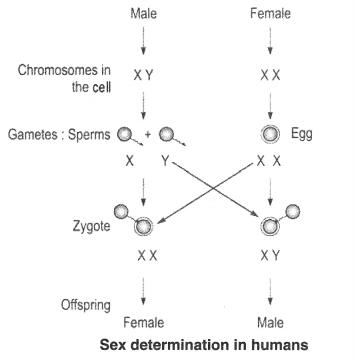
Page Number: 150
Question 1.
What are the different ways in which individuals with a particular trait may increase in a population ?
Answer:
Different ways in which individuals with a particular trait may increase in a population are as follow :
- If it gives the benefit of survival through natural selection.
- Due to a sudden increase in a particular trait in a population, i.e., by genetic drift.
Question 2.
Why are traits acquired during the life-time of an individual not inherited ?
Answer:
The traits acquired during the life-time are changes in the non-reproductive cells of the organisms and are not capable of being passed on to the next generation.
Question 3.
Why are the small numbers of surviving tigers a cause of worry from the point of view of genetics ?
Answer:
The small numbers of surviving tigers are a cause of worry from the point of view of genetics because in tigers there are negligible genetic variations. Due to this they are not well adapted. The rapid environmental changes cannot be favouable for them. If these changes are not controlled, tigers would be wiped out.
Page Number: 151
Question 1.
What factors would lead to the rise of a new species ?
Answer:
The factors that would lead to the rise of a new species are the following :
- Geographical isolation of a population caused by various types of barriers (such as mountain ranges, rivers and sea). The geographical isolation leads to reproductive isolation due to which there is no flow of genes between separated groups of pupulation.
- Genetic drift caused by drastic changes in the frequencies of particular genes by chance alone.
- Variations caused in individuals due to a natural selection.
Question 2.
Will geographical isolation be a major factor in the speciation of a self- pollinating plant species ? Why or why not ?
Answer:
The geographical isolation cannot be major factor in the speciation of a self-pollinating plant species because it does not have to look the plants for its process of reproduction to be carried out.
Question 3.
Will geographical isolation be a major factor in the speciation of an organism that reproduces asexually ? Why or why not ?
Answer:
Geographical isolation cannot be a major factor in the speciation of an asexually reproducing organism because it does not require any other organism to carry out reproduction.
Page Number: 156
Question 1.
Give an example of characteristics being used to determine how close two species are in evolutionary terms.
Answer:
If similar characteristics are shown in different organisms, then these are considered to be inherited from the common ancestry. It also shows the closeness of the species.
For example, bats and birds have some similarity in their wings, so they are closely related, while lizard and squirrel do not have wings so these are not closely related to the birds and bats.
Question 2.
Can the wing of a butterfly and the wing of a bat be considered homologous organs ? Why or why not ?
Answer:
The wings of a butterfly and the wings of a bat cannot be considered to be homologous organs because they have different basic designs though they are used for the same purpose of flying. They are analogous organs.
Question 3.
What are fossils ? What do they tell us about the process of evolution ?
Answer:
Fossils : Fossils are the remains or traces of a dead organism. These are formed through the formation of sedimentary rocks. They provide following information on the process of evolution.
- They tell about the changes that occured on the earth’s surface and the corresponding organisms.
- They tell about the gradual development of complex structured organisms from simple structured organisms.
- It is known through them that birds are evolved from reptiles.
- They state that angiosperms are developed from pteriodophytes and gymnosperms.
- They exhibit the process of humana evolution.
Page Number: 158
Question 1.
Why are human beings who look so different from each other in terms of size, colour and looks said to belong to the same species ?
Answer:
This is because although genetic make up of humans may be slightly different in different races of people, there is no reproductive isolation. Reproductive isolation differentiates one species from the other. Human beings different in size, colour and looks can marry among themselves and produce fertile offspring.
Question 2.
In evolutionary terms, can we say which among bacteria, spiders, fish and chimpanzees have a ‘better’ body design ? Why or why not ?
Answer:
Bacteria is a primitive organism as they came into being very early in evolution. But these organisms are still surviving in the present conditions after millions of years. This is because they have adapted well to the changing environment over these years. Same is the case for all other organisms like spiders, fishes and chimpanzees which have adapted to their environment and have survived. Therefore, all the organisms which exist have a body design which is better as it is suited to their environment.
NCERT Solutions for Class 10 Science Chapter 9 Textbook Chapter End Questions
Question 1.
A Mendelian experiment consisted of breeding tall pea plants bearing violet flowers with short pea plants bearing white flowers. The progeny all bore violet flowers, but almost half of them were short.
This suggests that the genetic make-up of the tall parent can be depicted as:
(a) TTWW
(b) TTww
(c) TtWW
(d) TtWw
Answer:
(c) TtWW
Question 2.
An example of homologous organs is :
(a) our arm and a dog’s fore-leg
(b) our teeth and an elephant’s tusks
(c) potato and runners of grass
(d) all of the above
Answer:
(d) All of the above
Question 3.
In evolutionary terms, we have more in common with :
(a) a Chinese school-boy
(b) a chimpanzee
(c) a spider
(d) a bacterium
Answer:
(a) A Chinese school-boy
Question 4.
A study found that children with light coloured eyes are likely to have parents with light coloured eyes. On this basis, can we say anything about whether the light eye colour trait is dominant or recessive ? Why or why not ?
Answer:
This information is not complete. On the basis of this, it cannot be decided light colour trait is dominant or recessive. So it cannot be said until one does not know the nature of this trait in the parents.
Question 5.
How are the areas of study-evolution and classification interlinked ?
OR
‘Two areas of study namely ‘evolution’ and ‘classification’ are interlinked”. Justify this statement. [AICBSE 2016]
Answer:
Classification of organisms is based on relative similarities and differences among organisms. Resemblances in organisms are because they have arisen from a common ancestor and differences in them are due to adaptations to different types of environment. Since the organisms can be graded in order of increasing complexity it indicates at the concept of evolution.
Question 6.
Explain the terms analogous and homologous organs with examples. [CBSE 2011,2013, 2014]
Answer:
Analogous organs : Those organs which have different basic structure (or different basic design) but have similar appearance and perform similar functions are called analogous organs.
For example, The wings of an insect and a bird are analogous organs.
Homologous organs : Those organs which have the same basic structure (or same basic design) but different functions are called homologous organs.
For example, The wing of a bat, flipper of a seal, front leg of a horse and arm of a man are homologous organs.
Question 7.
Outline a project which aims to find the dominant coat colour in dogs.
Answer:
Suppose a black homozygous male is mated with a white homozygous female. If the progeny has all black dogs then the dominant coat colour is black.
Question 8.
Explain the importance of fossils in deciding evolutionary relationships.
Answer:
Fossils play important role in providing evolutionary evidences because by knowning the age of fossils we can know about the evolution process of an organism.
For example, a fossil bird called archaeopteryx that looked like a bird had many other features of reptiles. It had feathered wings like those of birds, but teeth and tail like those of reptiles. Archaeopteryx is, therefore, a connecting link between the reptiles and birds, and hence suggests that the birds have evolved from the reptiles.
Question 9.
What evidence do we have for the origin of life from inanimate matter ? [CBSE 2011, 2014]
Answer:
A British scientist J.B.S. Haldane at first in 1929 suggested that life is originated from inanimate matter. According to him life must have developed from the simple inorganic molecules which were present at that time. Later, Miller and Urey in 1953 presented its evidences. They assembled an apparatus to create an early earth atmosphere which was supposed to consist of gases like methane, ammonia and hydrogen sulphide, etc. over water. This was maintained at a temperature just below 100°C and electric sparks were then passed through the mixture of gases to stimulate lightning for about one week. At the end of one week, it was found that about 15 per cent of carbon (from methane) had been converted into simple compounds and amino acids which make up protein molecules formed in living organisms. This experiment provides the evidence that the life originated from inanimate matter (or lifeless matter) like inorganic molecules.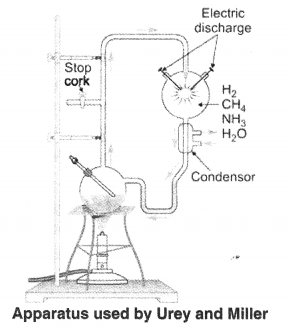
Question 10.
Explain how sexual reproduction gives rise to more viable variations than asexual reproduction. How does this affect the evolution of those organisms that reproduce sexually ? [CBSE 2011,2014]
Answer:
During sexual reproduction there is ‘crossing over’ of chromosomes, that gives rise to variations. These variations are inherited and increase the chances of survival of an organism.
- In sexual reproduction variations may occur due to errors in DNA copying.
- There may be variations due to interchange of homologous chromosomes during crossing over of male and female.
- In sexual reproduction, it is not predetermined that which gamete would fuse with another gamete. It depends only on chance. It is also a reason of variation.
These variations enable the organisms to adapt themselves to the changing conditions and also help to give rise to new species.
Question 11.
How is the equal genetic contribution of male and female parents ensured in the progeny ? [CBSE 2011, 2013]
Answer:
Genetic material in most organisms is present in pairs of chromosomes. Gametes in the sexually reproducing organisms are formed by the process of meiosis during which half of the genetic material goes into each gamete. When the gametes from male and female parents fuse with each other during sexual reproduction, the normal complement is restored. Half of the genetic material comes from the female and half from the male.
Question 12.
Only variations that confer an advantage to an individual organism will survive in a population. Do you agree with this statement ? Why or why not?
Answer:
Yes, variations that confer an advantage to an individual organism are inherited. The organism can survive longer in an environment and maintain its existence in the population.
NCERT Solutions for Class 10 Science Chapter 9 Heredity and Evolution
Heredity and Evolution: Heredity; Mendel’s contribution- Laws for inheritance of traits, Sex determination : brief introduction; Basic concepts of evolution.
| Board | CBSE |
| Textbook | NCERT |
| Class | Class 10 |
| Subject | Science |
| Chapter | Chapter 9 |
| Chapter Name | Heredity and Evolution |
| Number of Questions Solved | 29 |
| Category | NCERT Solutions |
Page 143
Question 1.
If a trait A exists in 10% of a population of an asexually reproducing species and a trait B exists in 60% Of the same population, which trait is likely to have arisen earlier ?
Answer: As species are asexually reproducing, there would be only very minor differences generated due to small inaccuracies in DNA copying, so trait B, which exists in 60% of the same population may get inherited earlier while trait A, which exists in 10% of the population may be originated late due to variations. Thus, trait B have arisen earlier since it is present in 60% of the same population.
Question 2.
How does the creation of variations in a species promote survival ?
Answer: Natural selection selects the individuals having useful variations which ensure their survival in the prevailing conditions of environment. Variant individuals that can withstand or cope with prevailing environment will survive better and will increase in number through differential reproduction.
Page 147
Question 1.
How do Mendel’s experiments show that traits may be dominant or recessive ?
Answer:
Mendel took pea plants with contrasting characteristics – tall plant and dwarf (short) plant. On cross pollination, he got all tall plants in F1 generation. Then by self pollination of F1 tall plants, he produced second generation (F2) consisting of tall and short plants in the ratio of 3 : 1. Then he concluded that, ‘T’ (tall) trait is dominant while ‘t’ trait for shortness is recessive.
Question 2.
How do Mendel’s experiments show that traits are inherited independently ?
Answer:
In a dihybrid cross made by Mendel, it was observed that when two pairs of traits or characters were considered; each trait expressed independent of the other. Thus, Mendel was able to propose the Law of Independent Assortment which says about independent inheritance of traits.
Question 3.
A man with blood group A marries a woman with blood O and their daughter has blood group O. Is this information enough to tell you which of the traits – blood group A or O is dominant ? Why or why not ?
Answer:
No. This information is not sufficient to determine which of the traits − blood group A or O − is dominant. This is because we do not know about the blood group of all the progeny.Blood group A can be genotypically AA or AO. Hence, the information is incomplete to draw any such conclusion.
Question 4.
How is the sex of the child determined in human beings?
Answer:
The females carry two X-chromosomes. Females produce one type of gametes (eggs) with same type of chromosomes (22 + X). Males have one X and one Y- chromosome. Among the male gametes, half of the sperms carry X-chromosome (22 X) and half
carry Y-chromosome (22 + Y). Thus, female is homogametic and male is heterogametic. When a sperm carrying X- chromosome fertilises an egg, the zygote develops into female (XX condition). When sperm carrying Y-chromosome fertilises an egg, the zygote develops into a male (XY condition). Thus, sex is determined at the time of fertilisation.
Page 150
Question 1.
What are the different ways in which individuals with a particular trait may increase in a population ?
Answer:
Different ways are : variation, natural selection and genetic drift (isolation).
Question 2.
Why are traits acquired during the lifetime of an individual not inherited ?
Answer:
Because acquired characters bring changes only in non-reproductive tissues and cannot change the genes of the germ cells. Thus, acquired traits cannot be passed to next generation.
Question 3.
Why are the small numbers of surviving tigers a cause of worry from the point of view of genetics ?
Answer:
(i) If any natural calamity occurs and kills these small number of surviving tigers, they can become extinct resulting in the loss of some genes forever.
(ii) Small number will lead to little recombination and, therefore, lesser variations. These both are very important for giving better survival chances to the species.
(iii) Less number of species means lesser extent of diversity and lesser number Of traits which reduces the chances of adaptability with respect to the change in the environment.
Page 151
Question 1.
What factors could lead to the rise of a new species ?
Answer:
Genetic variations, natural selection and reproductive isolation could lead to the rise of a new species.
Question 2.
Will geographical isolation be a major factor in the speciation of a self-pollinating plant species ? Why or why not ?
Answer:
No, because pollination occurs on the same plant in self-pollinating plant species.
Question 3.
Will geographical isolation be a major factor in the speciation of an organism that reproduces asexually ? Why or why not ?
Answer:
No, because asexual reproduction involves single parent or organism.
Page 156
Question 1.
Give an example of characteristics being used to determine how close two species am in evolutionary terms ?
Answer:
Homologous organs, analogous organs and vestigial organs help to identify evolutionary relationships amongst the species.
Question 2.
Can the wing of butterfly and the wing of a bat be considered homologous organs ? Why or why not ?
Answer:
No, wing of a bat and wing of a bird cannot be considered as homologous organs because they have different basic structure.
Question 3.
What are fossils ? What do they tell us about the process of evolution ?
Answer:
Fossils are the impression or remains of ancient life found preserved in the sedimentary rocks. Fossils are direct evidences of evolution. Fossils also help to identify evolutionary relationship between apparently different species. They also tell about the extent of evolution that has taken place.
Page 158
Question 1.
Why are human beings who look so different from each other in terms of size, colour and looks said to belong to the same species ?
Answer:
They look different because of interaction of genes with environment which results in change in their appearance. But they belong to the same species as they have same number of chromosomes and can breed among themselves.
Question 2.
In evolutionary terms, can we say which among bacteria, spiders, fish and chimpanzees have a ‘better body design’ why or why not ?
Answer:
No, because different designs are the product of evolution and different species have different body design to suit or adapt to their environment.
Page 159
Question 1.
A Mendelian experiment consisted of breeding tall pea plants bearing violet flowers with short pea plants bearing whfte flowers. The progeny all bore violet flowers, but almost half of them are short. This suggests that the genetic make-up of the tall parent can be depicted as
(a) TTWW
(b) TTww
(c) TtWW
(d) TtWw
Answer:
(c) Genetic make-up of tall plant can be depicted by TtWW.
Question 2.
An example of homologous organs is
(a) our arm and a dogs fore-leg.
(b) our teeth and an elephants tusks.
(c) potato and runners of grass.
(d) All of the above.
Answer:
(d) Both organs in all options have same basic structural design but have different functions and appearance.
Question 3.
In evolutionary terms, we have more in common with
(a) a Chinese school-boy.
(b) a chimpanzee.
(c) a spider.
(d) a bacterium.
Answer:
(a) A Chinese school-bpy is also a human being.
Question 4.
A study found that children with light-coloured eyes are likely to have parents with light-coloured eyes. On this basis, can we say anything about whether the light eye colour trait is dominant or recessive? Why or why not?
Answer:
We can say that light eye colour trait is dominant because only dominant traits are expressed in the first generation.
Question 5.
How are the areas of study – evolution and classification— inteilinked?
Answer:
Evolution and classification are interlinked with each other in many ways. Classification is the most important term to explain evolution. It is based on the similarities and differences between two species or among two organisms. More closer the characteristics, the moe doser is the evolution and chances to be in the same group of classification. Thus, the classification of species is a reflection of their evolutionary relationship.
Question 6.
Explain the terms analogous and homologous organs with examples.
Answer:
Analogous organs are those organs which have different basic structural designs and developmental origins but have similar appearance and perform similar functions.
Examples:
Wings of an insect and wings of a bat.
Homologous organs are those organs which have the same basic structural design and developmenta’ origin but have different functions and appearance.
Examples: Forelimbs of frog and forelimbs of human.
Question 7.
Outline a project which alms to find the dominant coat colour in dogs.
Answer:
A homozygous black (RB) male dog and a homozygous white (bb) female dog is taken and given to mate and produce offspring in F1 generation. If black colour is dominant out of every 4 dogs, 3 will be black and if white colour is dominant 3 out of 4 dogs will be white.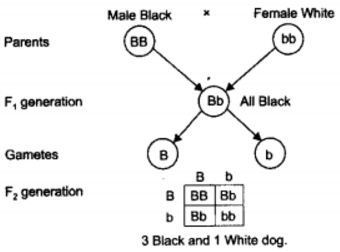
Question 8.
Explain the importance of fossils in deciding evolutionary relationships.
Answer:
Fossils and their study is useful to know about the species which are no longer alive. They provide evidence and missing links between two classes. They are helpful in forming a sequence of organisms in the pathway of evolution. Thus, fossils have importance in deciding evolutionary relationships.
Question 9.
What evidence do we have for the origin of life from inanimate matter?
Answer:
Stanley L. Miller and Harold C. Urey provided evidence regarding origin of life from inanimate matter. They assembled an atmosphere similar to that existed on early earth. The atmosphere had molecules like ammonia, methane, hydrogen sulphide and water, but no oxygen. The mixture was maintained at a temperature just below 100◦C and sparks were passed through the mixture of gases. At the end of a week, 15% carbon from methane had been converted to simple compounds of carbon like aminoacids which make up protein molecules. So, life arose afresh on earth.
Question 10.
Explain how sexual reproduction gives rise to more viable variations that asexual reproduction. How does this affect the evolution of those organisms that reproduce sexually ?
Answer:
Variations occurring during sexual reproduction may be due to:
- Separation of homologous chromosomes (by chance only) during gamete formation.
- Crossing over (recombination) of homologous chromosomes.
- Fertilisation of gametes to form zygote.
- Errors during DNA copying or mutations.
In asexually reproducing organisms only errors during DNA copying or mutations cause variations.
Since the extent of variations is much larger in sexually reproducing organisms, therefore, the chances of evolution is also much in sexually reproducing These variations enable the organisms to adapt themselves to the changing conditions and also help to face the struggle for Over the time, they and rise to new species.
Question 11.
How is the equal genetic contribution of male and female parents ensured in the progeny?
Answer:
Genetically organisms are of types
(i) Haploid : They have single set of chromosomes, where each chromosome is represented singly. As the chromosomes are the bearer of genes so haploids have single set of genes. A single gene determines the expression of character.
(ii) Diploid : ‘They have two sets Of homologous chromosomes, where the chromosome occur in pair, one maternal contributed by the mother through her ovum and the second Of the pair is contributed by the male parent through his sperm. The resultant cell zygote produces by the fusion of male and female gametes have two sets of chromosomes – each set contributed’ by each parent. In diploids a character is controlled by two genes/factors. Both the father and mother contribute practically equal amount of genetic material to the child. It means that each trait can be influenced by both paternal and maternal DNA.
Question 12.
Only variations that confer an advantage to an individual organism will survive in a population. Do you agree with this statement ? Why or why not ?
Answer:
No, many of the times the variations are not advantageous to an individual organism but still survive in a population, e.g., take the case of free ear lobe and attached ear lobe. Most of the other variations not only give survival advantage to an individual but also contribute to genetic drift. Thus, we can say that most of the variations lead to better adaptation of an organism to the changing environment. In this way, it gives survival advantage to that organism and will also survive in the coming population.
Multiple Choice Questions (MCQs) [1 Mark each]
Question 1.
An example of homologous organs is [NCERT]
(a) our arm and a dog’s foreleg
(b) our teeth and an elephant’s tusks
(c) potato and runners of grass
(d) All of the above
Answer:
(a) Our arm and a dog’s foreleg is the example of homologous organs.
Question 2.
The science, which deals with study of heredity and variations is called
(a) phylogeny
(b) embryology
(c) genetics
(d) palaeontology
Answer:
(c) The genetics is the study of heredity and variations and includes their occurrence, causes, benefits, disadvantages, significance, etc.
Question 3.
Archaeopteryx is a connecting link between
(a) reptiles and aquatic animals
(b) birds and insects
(c) reptiles and birds
(d) birds and dinosaurs
Answer:
(c) Archaeopteryx is a connecting link- between the reptiles and birds. It appears like a bird, but has other features which are present in reptiles, e.g. it has wings like bird, but teeth and tail like the reptilians.
Question 4.
For palaeontological studies a scientist will gather the evidences from
(a) study of homology
(b) study of analogy
(c) fossils
(d) All of these
Answer:
(d) Study of homologous and analogous organs indicates the origin and modification in organisms and study of fossils indicates the age and features of an organism.
Question 5.
In evolutionary terms, we have more in common with [NCERT]
(a) a Chinese school boy
(b) a chimpanzee
(c) a spider
(d) a bacterium
Answer:
(a) Chinese school boy because both of us belong to the same species, i.e. Homo sapiens.
Question 6.
Aditya was observing some organisms in lab and tried to compare them. The presence of which organs will confirm to him that they share evolutionary history?
(a) Analogous organs
(b) Paralogous organs
(c) Homologous organs
(d) None of these
Answer:
(c) Homologous organs are present in organisms who share evolutionary history. However, these organs perform different functions in different organisms.
Question 7.
New species may be formed if
I. DNA undergoes significant changes in germ cells. .
II. chromosome number changes in the gamete.
III. there is no change in the genetic material.
IV. mating does not take place.
(a) I and II
(b) I and III
(c) II, III and IV
(d) I, II and III
Answer:
(a) New species may be formed if the DNA changes are severe enough, such as a change in the number of chromosome. This leads to new variations.
Question 8.
Which of the following statements is not true with respect to variation?
(a) All variations in a species have equal chance of survival.
(b) Change in genetic composition results in variation.
(c) Selection of variants by environmental factors forms the basis of evolutionary processes.
(d) Variation is minimum in asexual reproduction.
Answer:
(a) All variations in a species do not have equal chances of survival. Some of the variations may be so drastic that the new DNA copy cannot work with the cellular apparatus it inherits. Such, a newborn cell dies soon.
Question 9.
Select the statement that describes characteristics of genes. .
(a) Genes are specific sequence of bases in a DNA molecule.
(b) A gene does not code for proteins.
(c) In individuals of a given species, a specific gene is located on a particular chromosome.
(d) Each chromosome has only one gene.
Answer:
(b) Genes are stretches of DNA found on chromosomes of a cell. A gene contains information for making proteins in a cell. A specific gene is located on a particular chromosome in individuals of a given species.
Question 10.
If a round, green seeded pea plant (RRyy) is crossed with wrinkled, yellow seeded pea plant (rrYY), the seeds produced in F1 – generation will be [NCERT Exemplar]
(a) round and yellow
(b) round and green
(c) wrinkled and green
(d) wrinkled and yellow
Answer:
(a) The cross between RRyy and rrYY seeds will produce RrYy (round and yellow) seeds in F1-generation, because round and yellow are the dominant traits.
Question 11.
From the list given below, select the character, which can be acquired but not inherited. [NCERT Exemplar]
(a) colour of eye
(b) colour of skin
(c) size of body
(d) nature of hair
Answer:
(c) Acquired traits develop in response to the environment. The size of the body is an acquired trait because it can vary based on the availability of less or more food. The other three colour of eye and skin and nature of hair are characters inherited from the parents.
Question 12.
According to the evolutionary theory, formation of a new species is generally due to [NCERT Exemplar]
(a) sudden creation by nature.
(b) accumulation of variations over several generations.
(c) clones formed during asexual reproduction.
(d) movement of individuals from one habitat to another
Answer:
(b) Accumulation of variations over several generations forms new species. Genetic drift accumulates different changes in sub-populations of a species. Also, natural selection may also operate differendy in the different geographic locations. Eventually, different groups of new species will be formed.
Question 13.
Select the incorrect statement. [NCERT Exemplar]
(a) Frequency of certain genes in a population changes over several generations resulting in evolution.
(b) Reduction in weight of the organism due to starvation is genetically controlled.
(c) Low weight parents can have heavy weight progeny.
(d) Traits which are not inherited over generations do not cause evolution.
Answer:
(b) The weight reduction due to starvation will not change the DNA of the germ cells, because low weight is not a trait that is genetically controlled or inherited. Also, low weight parents may have heavy weight progeny.
Question 14.
In human males all the chromosomes are paired perfectly except one. This/these unpaired chromosome is/are
I. large chromosome
II. small chromosome
III. Y-chromosome IV X-chromosome
(a) I and II
(b) Only III
(c) III and IV
(d) II and IV
Answer:
(c) In human males, one pair called the sex chromosomes are unpaired. Here, one is a normal-sized X-chromosome while other is a short Y-chromosome. Women have a perfect pair of sex chromosomes, both called X.
Question 15.
Rajneesh was studying the fossils of two different types, fossil A was found in upper layer of Earth and B in deeper layers. What can be predicted regarding the age of these fossils?
(a) A has recently become extinct
(b) B has become extinct recently
(c) The time of extinction cannot be determined
(d) None of the above
Answer:
(a) Since, fossil A was found in upper layer of earth, it suggests that the organism has become extinct recently. Fossil B found in deeper layer must have become extinct long time ago and deposition of other layers occurred over it during this period.
Question 16.
A Mendelian experiment consisted of breeding tall pea plants bearing violet flowers with short pea plants bearing white flowers. The progeny all bore violet flowers, but almost half of them were short. This suggests that the genetic makeup of the tall parents can be depicted as [NCERT]
(a) TTWW
(b) TTww
(c) TtWW
(d) TtWw
Answer:
(c) Parent with genotype TtWW produce two types of gametes TW and tW, while the other with genotype ttww produce only one type of gamete W.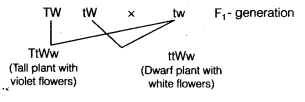
NCERT Solutions for Class 10 Science Chapter 9 Heredity and Evolution (Hindi Medium)
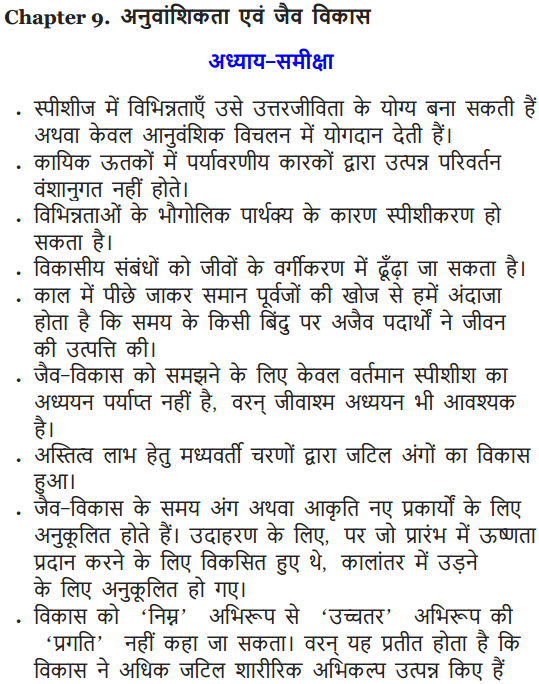
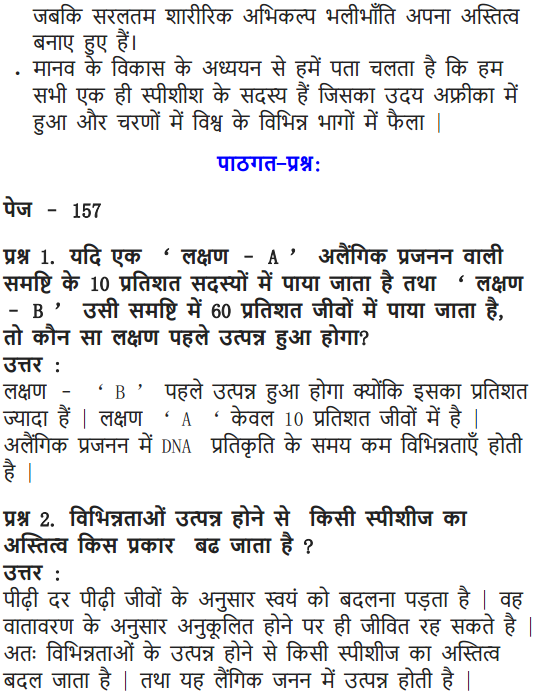
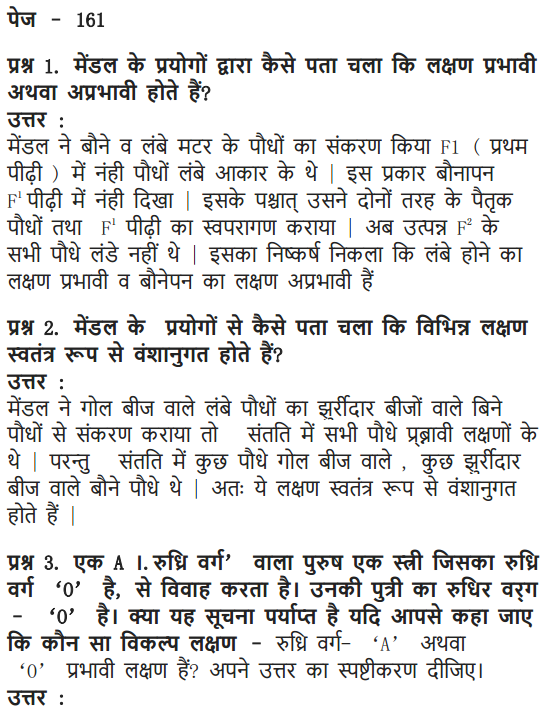
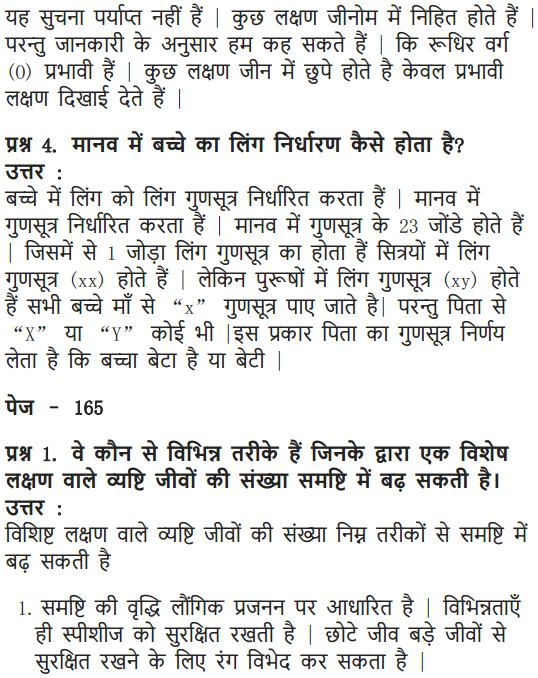
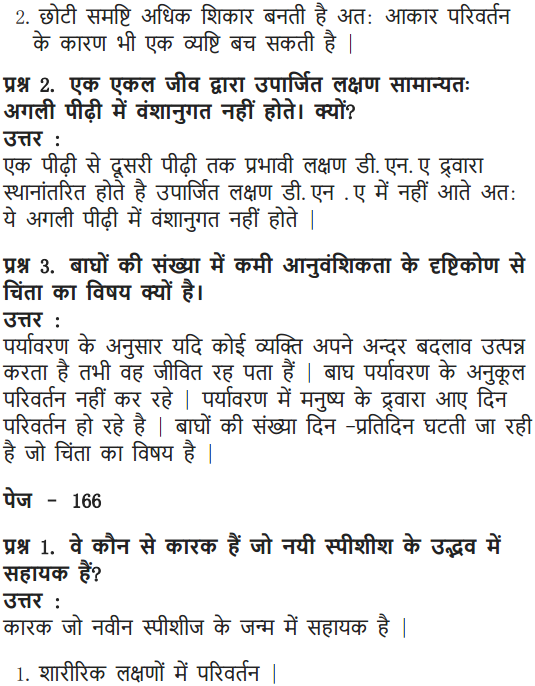
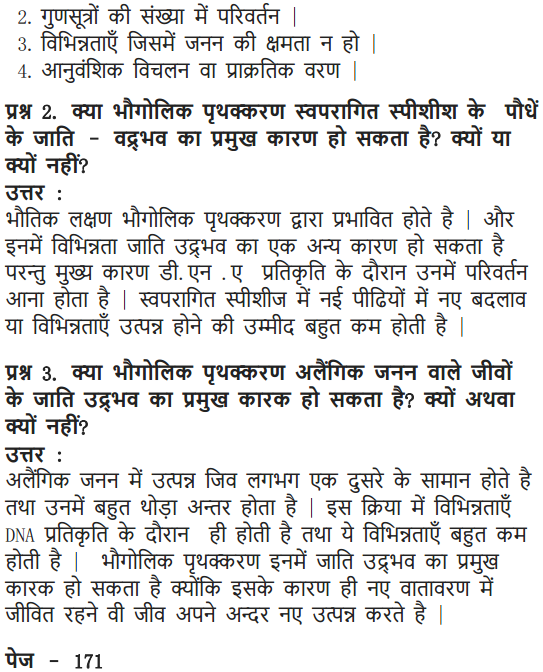
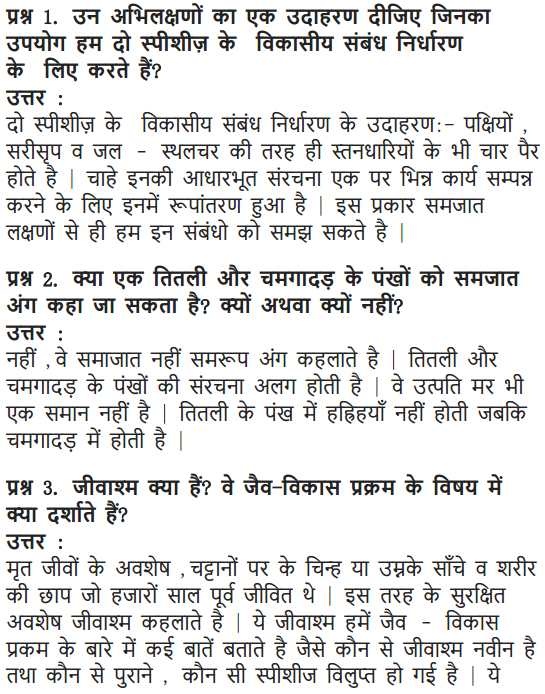
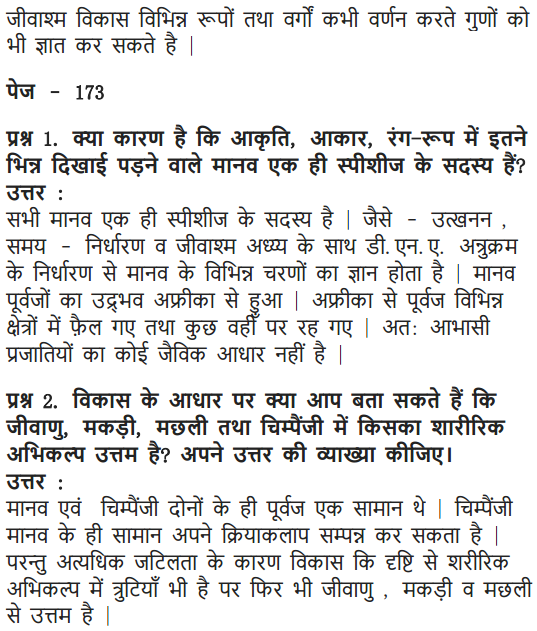
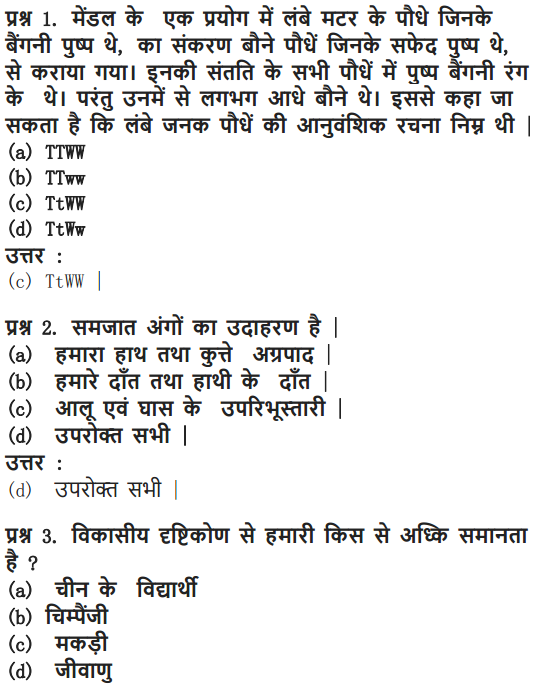
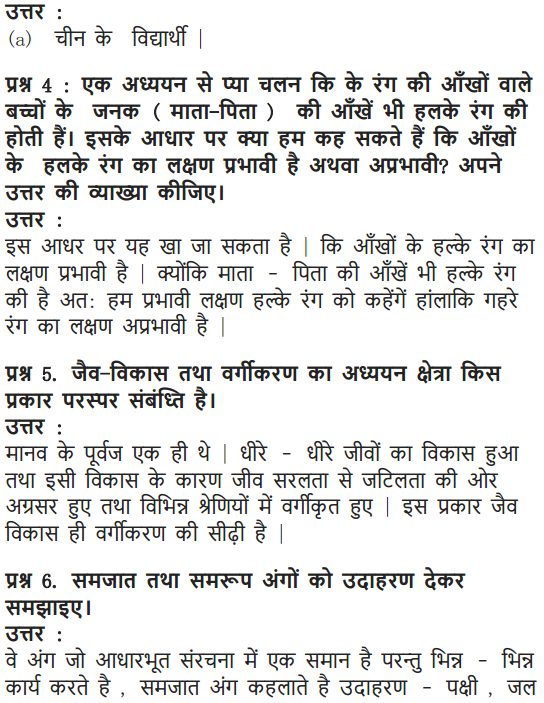
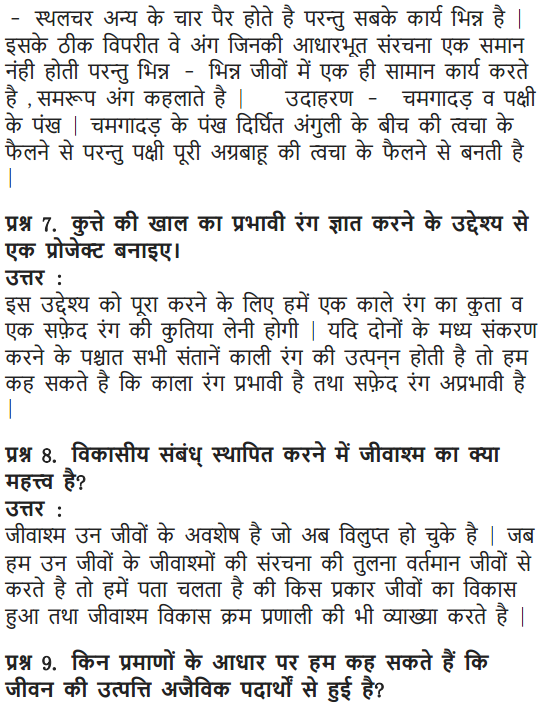
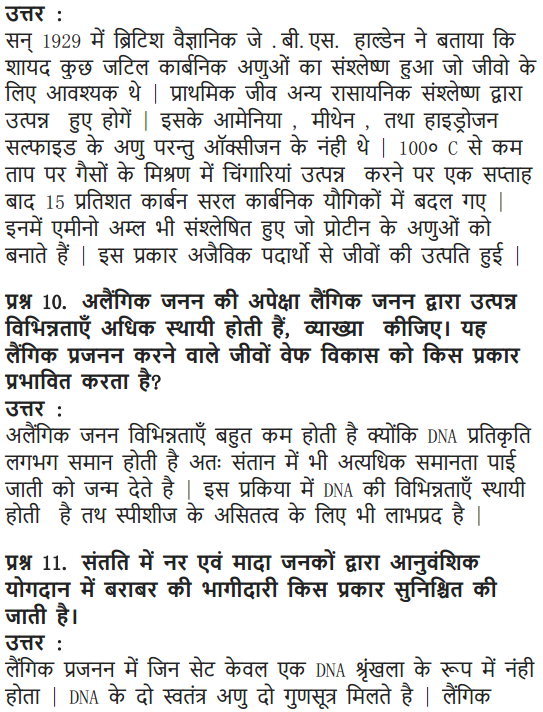
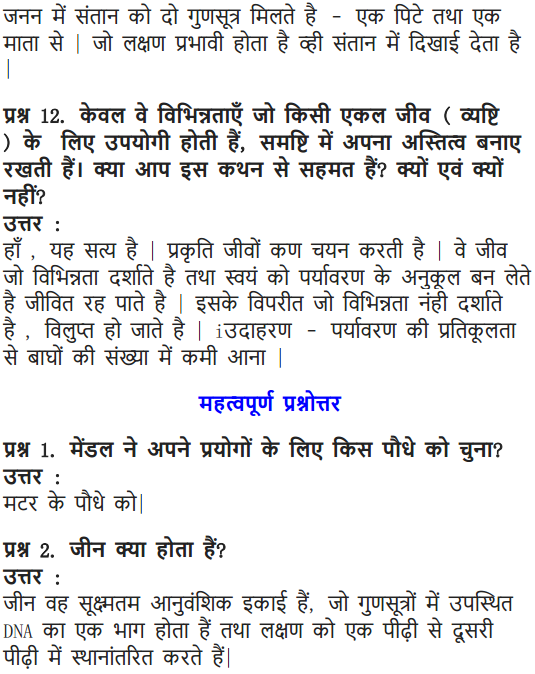
Class 10 Science Heredity and Evolution Mind Map
Accumulation Of Variation During Reproduction
- Characters or features or traits are inherited from one generation to the next during reproduction.
- This inheritance provides both a common basic body design & subtle changes in it for next generation.
- When this generation reproduces, the offspring would have differences they inherit from previous generation as well as newly created differences.
- Accumulation of these differences generation after generation leads to the development of variations in a population.
- Different variations provide different advantages to the population and the variation which provide best survival advantages are inherited to the next generation.
- For e.g. bacteria having variation to tolerate heat will survive and multiply better in heat wave.
Heredity
Heredity refers to the transmission of characteristics from parent to offspring by means of genes in the chromosomes.
Mendel’s Contributions
- Mendel was the first scientist whose studies lead to the formulation of laws of inheritance.
- He conducted cross hybridization experiments of garden pea plant (Pisum sativum) and studied the transmission of characters that had two contrasting traits such as round/wrinkled seeds, tall/short plants, white/’violet flowers etc.
Experiment 1: He cross pollinate pure breeds of tall (TT) & dwarf (tt) pea plant and calculated the percentages of tall & dwarf progeny.
Observation: F1 generation was tall (Tt) with no halfway characteristics.
F2 generation produced by self pollination of F1 included tall and short plants in 3:1. (Genotypic ratio 1:2:1 for TT:Tt:tt)
Inference: This indicates that both the tallness & shortness traits were inherited in the F, plants, but only the tallness trait was expressed.
Thus, two copies of the trait are inherited in each sexually reproducing organism. These two may be identical (TT or tt) or may be different (Tt), depending on the parentage.
Conclusion: This study leaded to the formulation of two laws:
Law of dominance: states that only one character expresses itself in F, generation.
Law of segregation: states that the two alleles of a character in an individual get separated or segregated during gamete formation and distributed randomly in gametes.
Experiment 2: He crossed the plant with two different characteristics such as tall plant with round seed and short plant with wrinkled seed. Other example may include round & green seeds (RRyy) and wrinkled & yellow seeds (rrYY).
Observation: F1 generation; all were tall & round i.e. tall & round are dominant.
F2 generation; tall plants with round seeds, tall with wrinkled seeds, short with round seeds, and short plants with wrinkled seeds in 9:3:3:1.
Similarly, round & yellow, round & green, wrinkled & yellow, and wrinkled & green in 9:3:3:1.
Inference: The tall/short trait and the round seed/wrinkled seed trait are independently inherited.
Conclusion: It formulated the law of independent assortment which states that genes of different characters located in different pairs of chromosomes are independent of one another in their segregation during gamete formation.
Sex Determination
Different species use different strategies for this:
- Environment: for e.g. the temperature at which fertilised eggs are kept determines the sex of developing animals in the eggs. It is observed in animals like crocodile, turtle etc.
- Snails can change sex. indicating that sex is not genetically determined.
- Sex of an individual is genetically determined for e.g. humans.
- Humans have 22 autosomal & 1 sex chromosome pairs. Females have XX & males have XY. Hence, sex of a child is determined by what he/she has inherited (X or Y) from the father since, child will always inherit X from the mother. If X is inherited from father then child will be a girl & if Y is inherited then a child will be a boy.
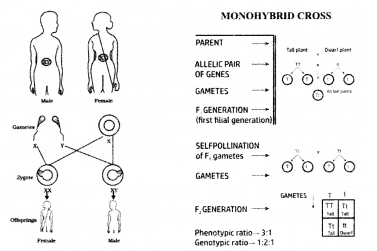
Evolution
- It refers to gradual change in the characteristics of the population (plants & animals) over successive generations.
- Errors in DNA copying during reproduction, mutations, & natural selection account for the evolution.
- Evolution gives rise to such a biodiversity at each level of biological organization such as at species level, among individuals, molecules etc.
Evolution And Classification
Classification is the process by which organisms are grouped into convenient categories based on some easily observable characters.
Characters such as cell type (prokaryote or eukaryote), single cell or multi cellular, presence or absence of nucleus, autotrophic (such as photosynthesis) or heterotrophic, sexual or asexual reproduction etc. are used to classify different organisms in different groups.
The more characteristics two species will have in common, the more closely they are related. And the more closely they are related, the more recently they will have had a common ancestor. For e.g. brother & sister are more closely related than a girl & her first cousin. Therefore, classification of species gives a reflection of their evolutionary relationship.
Tracing Evolutionary Relationships
Few evidences which help us to trace evolutionary
relationships among different organisms or species:
- Comparative anatomy and morphology: study of similarities & differences among organisms to understand the common ancestry’.
- Homologous: Similar structure different functions. It indicates common ancestry for e.g. bones of forelimbs in frog, lizard, bird & human.
- Analogous: Similar functions but different structure. Different structures evolved for same function & hence having similarity. For e.g. wings of bats & birds, eye of octopus & mammals, etc.
- Fossils: Remains of hard parts of life-forms found in rocks. They represent extinct organisms (e.g., Dinosaurs).
- The age of the fossils can be estimated by two ways; relative depth of the fossils, dating fossils i.e. detection of ratios of different isotopes of the same element in the fossil material
Speciation
- It refers to a gradual evolutionary process by which populations evolve to become different species.
- Reproductive and geographical isolation play an important role in the process of speciation. They result in change in the frequency of an existing gene variant in a population i.e. genetic drift.
- Over generations, genetic drift along with natural selection results in the formation of new’ species,
- Other factors that may result in speciation are sudden severe DNA changes (mutation) such as change in chromosomal no., variation such as female green beetle will not mate with red males. Her behavior ensures the reproductive isolation between them and thus results in generation of new’ species.
Evolution Should Not Be Equated With ‘progress’
- Evolution is simply the generation of diversity & shaping of diversity by environmental selection.
- The only progressive trend in evolution seems to be the emergence of more and more complex body designs over time. However, that doesn’t mean that the older designs are inefficient.
- For e.g. simplest life forms; bacteria inhabits the most inhospitable habitats like hot springs, deep-sea thermal vents & ice in Antarctica.
Human Evolution
- Tolls, like excavating, time-dating and studying fossils, determining DNA sequences etc, have been used for studying human evolution.
- All humans are a single species regardless of skin color or human races.
- The earliest members of the human species, Homo sapiens, can be traced back to Africa i.e. we all come from Africa.
- A couple of hundred thousand years ago, some of our ancestors left Africa while others stayed on.
- The migrants slowly spread across the planet; from Africa to West Asia, then to Central Asia, Eurasia, South Asia, & East Asia.
- They travelled down the islands of Indonesia and the Philippines to Australia, and they crossed the Bering land bridge to the Americas.
We hope this detailed article on NCERT Solutions For Class 10 Science Chapter 9 Heredity and Evolution is helpful. If you have any query regarding this article or NCERT Solutions For Class 10 Science Chapter 9 Heredity and Evolution, leave your comments in the comment section below and we will get back to you as soon as possible.
Important Questions of Heredity and Evolution Class 10 Science Chapter 9
Question 1.
All the variations in a species do not have equal chances of survival. Why? (Foreign 2014)
Answer:
All the variations do not have equal chances of survival in the environment in which they live. Depending on the nature of variations, different individuals would have different kinds of advantages. The organisms which are most adapted to the environment will survive.
Question 2.
“Only variations that confer an advantage to an individual organism will survive in a population.” Justify this statement. (Foreign 2011)
Answer:
Variations are the structural, functional or behavioural changes from the normal characters developed in the living organisms. Inheritable variations participate in evolution. According to Darwin, natural selection sorts out individuals with favourable variations. Such organism will survive, reproduce more and thus, will leave more progenies. Hence, useful variations get established in nature.
Question 3.
Assertion (A) : The sex of a child in human beings will be determined by the type of chromosome he/she inherits from the father.
Reason (R) : A child who inherits ‘X’ chromosome from his father would be a girl (XX), while a child who inherits a ‘Y’ chromosome from the father would be a boy (XY).
(a) Both (A) and (R) are true and (R) is the correct explanation of the assertion (A).
(b) Both (A) and (R) are true, but (R) is not the correct explanation of the assertion (A).
(c) (A) is true, but (R) is, false.
(d) (A) is false, but (R) is true. (2020)
Answer:
(a) Both (A) and (R) are true and (R) is the correct explanation of the assertion (A).
Question 4.
A Mendelian experiment consisted of breeding pea plants bearing violet flowers with pea plants bearing white flowers. What will be the result in F1 progeny? (2018)
Answer:
According to the Mendelian experiment, violet coloqr (VV) is a dominant trait while white colour (ww) is a recessive trait. Hence, the colour of the flower in F1 progeny will be violet (Vw).
Question 5.
Name the information source for making proteins in the cells. (Delhi 2014)
Answer:
Deoxyribonucleic acid (DNA) present in the chromosomes of cell nucleus is the information source for making proteins.
Question 6.
What is a gene? (AI 2014)
Answer:
A gene is a unit of DNA on a chromosome which governs the synthesis of particular protein that controls specific characteristics (or traits) of an organism.
Question 7.
What is heredity? (AI 2014)
Answer:
The inheritance of characters (or trails) from the parents to their offsprings is called heredity.
Question 8.
Why is the progeny always tall when a tall pea plant is crossed with a short pea plant? (Foreign 2014)
Answer:
When a tall pea plant is crossed with a short pea plant, the resultant progeny is always tall because tall is dominant trait and short is recessive trait. Therefore, dominant trait expresses itself in the progeny.
Question 9.
Write a difference between inherited traits and acquired traits giving one example of each. (Delhi 2013C)
Answer:
A trait (or characteristic) of an organism which is ‘not inherited’ but develops in response to the environment is called an acquired trait. For example, if a group of mice are normally bred, all their progeny will have tails. Now, if the tails of these mice are cut by surgery in each generation, tail-less mice will not be produced. This is so because removal of tail is an acquired character.
A trait (or characteristic) of an organism which is caused by a change in its genes (or DNA) is called an inherited trait. Inherited traits can be passed on to the progeny of the organism because they have produced changes in the genes (or DNA) of the organism. For example, skin colour in human beings.
Question 10.
(a) Why did Mendel carry out an experiment to study inheritance of two traits in garden pea?
(b) What were his findings with respect to inheritance of traits in F1 and F2 generation?
(c) State the ratio obtained in the F2 generation in the above mentioned experiment. (2020)
Answer:
(a) Mendel carried out crosses with two traits to see the interaction and basis of inheritance between them. In a dihybrid cross given by Mendel, it was observed that when two pairs of characters were considered each trait expressed independent of the other.
(b) For example, a cross between round yellow and wrinkled green parents.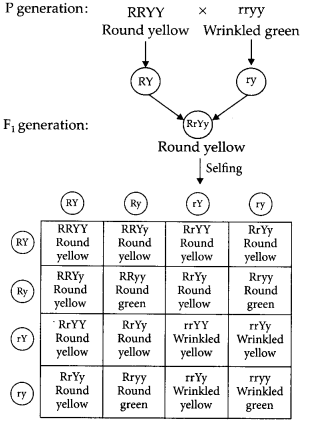
In F1 generation, all plants are with round yellow seeds. But in F2 generation, we find all types of plants : Round yellow, Round green, Wrinkled yellow, Wrinkled green.
F2 generation ratio : Round-yellow = 9 : Round- green = 3 : Colour of stem in F1 progeny Wrinkled- yellow = 3 : Wrinkled-green = 1
Question 11.
A green stemmed rose plant denoted by GG and a brown stemmed rose plant denoted by gg are allowed to undergo a cross with each other.
(a) List your observations regarding :
(i) Colour of stem in their F1 progeny
(ii) Percentage of brown stemmed plants in F2 progeny if plants are self pollinated.
(iii) Ratio of GG and Gg in the F2 progeny.
(b) Based on the findings of this cross, what conclusion can be drawn? (2020)
Answer:
(a) (i) Colour of stem in F1 progeny: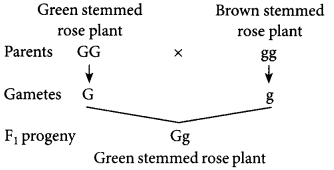
The colour in the F1 progeny is green stemmed as green stem colour is dominant.
(ii) F1 progeny on self pollination: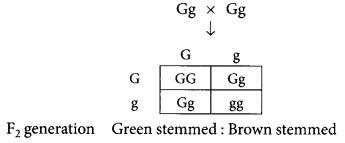
F2 generation Green stemmed: Brown stemmed
(iii) Ratio of GG and Gg in F2 progeny:
Genotype of F2 progeny – GG : Gg
1 : 2
(b) This is a monohybrid cross. This shows that out of two contrasting traits only one dominant trait appears in F1 generation and the trait which does not express is recessive. On selfing the F1 plants, both the traits appear in next generation but in a definite proportion.
Question 12.
(a) Why is the F1 progeny always of tall plants when a tall plant is crossed with a short pea plant?
(b) How is F2 progeny obtained by self-pollination of F1 progeny different from F1 progeny? Give reason for this observation.
(c) State a conclusion that can be drawn on the basis of this observation. (2020)
Answer:
(a) When a tall plant (TT) is crossed with a short tea plant (tt), only tall plants are obtained in F1 progeny. It is because out of two contrasting traits only one appears in the progeny of first generation. This means that the trait which appears in F1 generation is dominant and the trait which does not express is recessive. The character TT for tall plant is dominant, so all the plants are tall.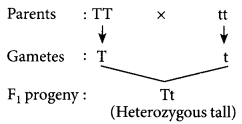
(b) On selfing F1 progeny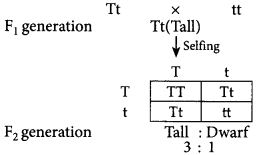
In F2 generation we obtained both tall and dwarf plants. Appearance of suppressed recessive trait in individuals of F2 generation in Mendelian cross indicates that characters of recessive traits are not lost. When the F1 generation plants were allowed to self-fertilise both the parental trait were expressed in definite proportion in F2 generation.
(c) Above observation shows that only one dominant allele is expressed. This is called law of dominance. In a heterozygous individual, two dissimilar alleles remain together and do not get mixed up. At the time of gamete formation, they separate so that each gamete receives only one allele is always pure. This is called “law of purity of gametes”.
Question 13.
Name the plant Mendel used for his experiment. What type of progeny was obtained by Mendel in F1 and F2 generations when he crossed the tall and short plants? Write the ratio he obtained in F2 generation plants. (Delhi 2019)
Answer:
Mendel selected garden pea (Pisum sativum) for his series of hybridisation experiments.
He first selected two pureline plants (tall plant having gene TT and short plant having gene tt) and then crossed such plants having contrasting characters. In the F1 generation, he observed that only one of the two contrasting character appeared, he called this character as dominant and the one which does not get expressed in F1 was called as recessive. He later selfed the F1 plants and observed that both the traits appear in next generation but in a definite proportion. This can be explained by the following cross :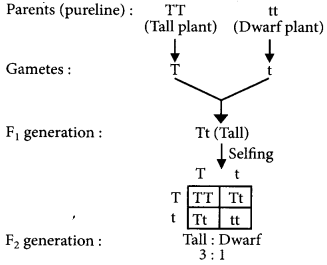
So, the plants of F1 generation will be all tall plants and after selfing the ratio of tall and dwarf plants that Mendel obtained in F2 generation plants is 3 : 1.
Question 14.
How did Mendels experiments show that different traits are inherited independently? Explain. (Delhi 2017)
Answer:
In a dihybrid cross given by Mendel, it was observed that when two pairs of traits or characters were considered, each trait expressed independent of the other. Thus, Mendel was able to propose the Law of Independent Assortment which says about independent inheritance of traits. This could be explained clearly from the given cross: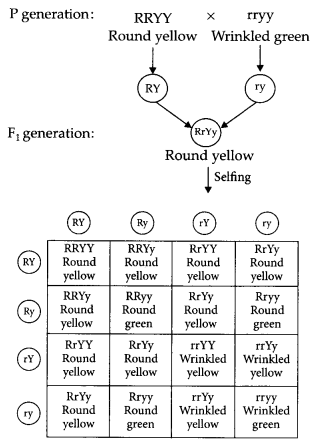
F2 generation ratio : Round-yellow = 9 : Round- green = 3: Wrinkled-yellow = 3: Wrinkled-green = 1
Question 15.
How did Mendel explain that it is possible that a trait is inherited but not expressed in an organism? (AI 2017)
Answer:
Mendel first selected two pure line plants. He then crossed such plants having contrasting characters. In the F1 generation, he observed that only one of the two contrasting character appeared, he called it dominant and the one which does not get expressed in F1 was recessive. He later selfed the F1 plants and observed that both the traits appear but in a definite proportion. It can be explained by the following cross :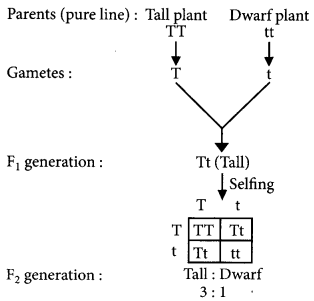
This is how Mendel explained that a trait may be inherited but not expressed in the plant.
Question 16.
In one of his experiments with pea plants Mendel observed that when a pure tall pea plant is crossed with a pure dwarf pea plant, in the first generation, F1 only tall plants appear.
(a) What happens to the traits of the dwarf plants in this case?
(b) When the F, generation plants were self- fertilised, he observed that in the plants of second generation, F2 both tall plants and dwarf plants were present. Why it happened? Explain briefly. (Delhi 2016)
Answer:
(a) Mendel’s monohybrid cross indicated that out of two contrasting traits only one appears in the progeny of first generation. This implies that the trait which appears in F1 generation is dominant and the trait which does not express is recessive. We can also say that gene controlling the dominant trait is dominant gene or allele and gene controlling the recessive trait is recessive gene or allele.
In F1 progeny although the dominant trait is expressed but genes for both dominant and recessive traits are present in a heterozygous condition. The recessive trait has a chance to express in next generation only if recessive genes come in homozygous condition. This can be illustrated by the given cross: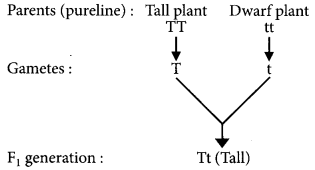
(b) Appearance of suppressed recessive trait in individuals of F2 generation in Mendelian cross indicates that the characters of recessive traits are not lost even when they are not expressed. When the F1 generation plants were allowed to self- fertilise, both the parental traits were expressed in definite proportion in F2 generation. This could be explained by the given cross by selfing the gametes obtained in F1 generation.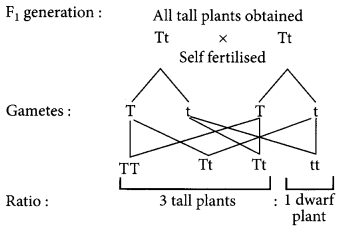
Question 17.
How did Mendel interpret his result to show that traits may be dominant or recessive? Describe briefly. (Delhi 2016)
Answer:
Mendel crossed the pea plant for two contrasting characters under consideration. The trait that expressed itself in F1 generation was dominant and the one not expressed in F1 generation was recessive. He later selfed the plants of F1 generation and recovered, both parental traits in a definite proportion in F2 generation. Mendel interpreted his results as, the trait that expressed itself in F1 was dominant and the one that reappeared in F2 generation was recessive. It can be demonstrated by the following cross: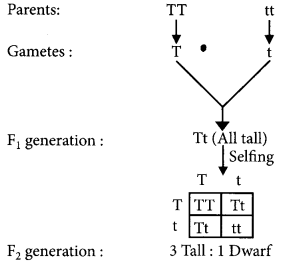
Question 18.
In a monohybrid cross between tall pea plants (TT) and short pea plants (tt) a scientist obtained only tall pea plants (Tt) in the F1 generation. However, on selfing the F1 generation pea plants, he obtained both tall and short plants in F2 generation. On the basis of above observations with other angiosperms also, can the scientist arrive at a law? If yes, explain the law. If not, give justification for your answer. (Delhi 2016)
Answer:
In the situation discussed in the question the scientist can arrive at two different laws, i.e., law of dominance and law of segregation (or law of purity of gametes). This can be explained with the help of following crosses: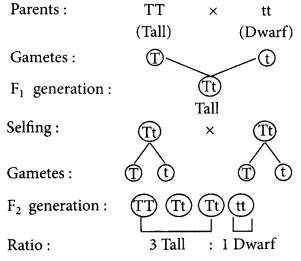
In F1 hybrid two dissimilar alleles are present for one character, i.e., height T is for tallness and t is for dwarfness, out of which only one allele called dominant allele expresses itself and the one which remains unexpressed is called recessive allele. This is called “law of dominance”.
Also the two dissimilar alleles that remain together in a heterozygous individual do not get mixed up and keep their distinct identity. Hence, at the time of gamete formation they separate so that each gamete receives only one allele and is always pure which enables reappearance of recessive trait in F2 progenies when the two recessive alleles come together. This is called “law of purity of gametes.”
Question 19.
How do Mendel’s experiment show that traits are inherited independently? (AI 2016)
Answer:
Refer to answer 14.
Question 20.
With the help of an example justify the following statement: “A trait may be inherited, but may not be expressed.” (AI 2016)
Answer:
A trait may be inherited but may not be expressed, this could be explained by the given example. When a tall pea plant was crossed with a dwarf pea plant, then F1 generation plants were all tall. When F1 plants were selfed, then F2 generation plants were both tall and dwarf. This shows that the F1 plants had inherited both the parental traits but did not express dwarfness or recessive trait in the presence of the trait for tallness or dominant trait. This could be explained by the given cross :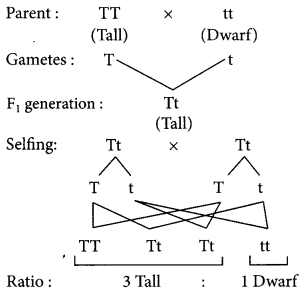
Question 21.
List two differences in tabular form between dominant trait and recessive traits. What percentage/proportion of the plants in the F2 generation/progeny were round, in Mendel’s cross between round and wrinkled pea plants? (Foreign 2016)
Answer:
Differences between dominant traits and recessive trait are given below:
| Dominant trait | Recessive trait |
| (i) It is the trait controlled by dominant allele. | It is the trait controlled by recessive allele. |
| (ii) It is the trait which is expressed in F1 generation. | It is the trait which remains suppressed in F1 generation and appears in F2 generation. |
Out of total 4 genotypes possible in F2 generation 31 genotypes result in phenotypic expression of round seeds. So, the percentage of plants with round seeds will be 75%. This can be illustrated as follows: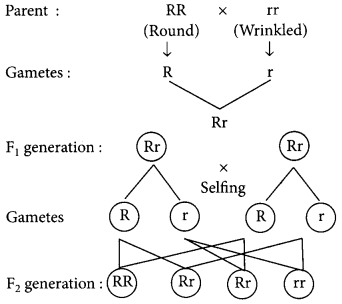
Question 22.
Explain Mendel’s experiment with peas on inheritance of characters considering only one visible contrasting character. (Foreign 2016, 2014)
Answer:
Mendel crossed a pure tall pea plant with pure dwarf pea plant. All the plants obtained in F1 generation were tall. When Mendel selfed plants from F1 generation then he obtained both tall and dwarf plants in F2 generation in the ratio of 3 : 1. This can be illustrated as follows :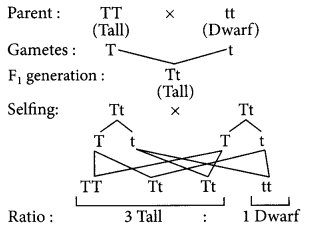
This explains that for each pair of contrasting characters there are two alleles. The trait which is expressed in F1 is dominant trait and is controlled by dominant allele and the trait which remains unexpressed in F1 is the recessive trait and is controlled by recessive gene. When both the contrasting alleles are present together in F1 individuals, no mixing of alleles occurs and they again segregate at the time of gamete formation Therefore, when the recessive alleles come together they result in reappearance of recessive trait in F2 generation.
Question 23.
“It is a matter of chance whether a couple will have a male or a female child.” Justify this statement by drawing a flow chart. (Foreign 2015)
Answer:
Sex is determined at the time of fertilisation when male and female gametes fuse. Male produces two types of gametes, i.e., having X or Y chromosome and female produces same type of gametes containing X chromosomes. The sex of the child is determined at the time of fertilisation when male and female gametes fuse to form zygote.
If a sperm (male gamete) carrying X chromosome fertilises an egg or ovum (female gamete) carrying X chromosome, then the offspring will be a girl (female). This is because the offspring will have XX combination of sex chromosomes.
If a sperm (male gamete) carrying Y chromosome fertilises an egg or ovum (female gamete) which has X chromosome, then the offspring will be a boy (male). This is because the offspring will have XY combination of sex chromosomes.
Therefore, there are 50% chance of a male child and 50% chance of a female child.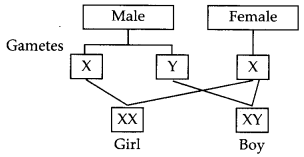
Question 24.
“It is possible that a trait is inherited but may not be expressed.” Give a suitable example to justify this statement. (Foreign 2015)
Answer:
Refer to answer 20.
Question 25.
A cross was made between pure breeding pea plants, one with round and green seeds and the other with wrinkled and yellow seeds.
(a) Write the phenotype of F1 progeny. Give reason for your answer.
(b) Write the different types of F2 progeny obtained along with their ratio when F1 progeny was selfed. (Delhi 2014, Delhi 2013C)
Answer:
(a) The given cross was made between pure breeding pea plants, one with round and green seeds and the other with wrinkled and yellow seeds.
Yellow seed colour and round seed shape is dominant over green seed colour and wrinkled seed shape. In F1 generation, dominant traits express itself, whereas recessive traits get suppressed.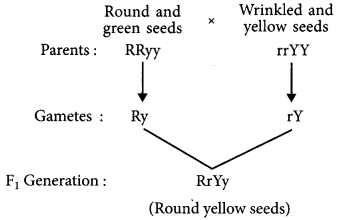
Therefore, the phenotype of F1 progeny is round and yellow.
(b) The different types of F2 progeny obtained along with their ratio when F1 progeny was selfed could be illustrated by the given cross.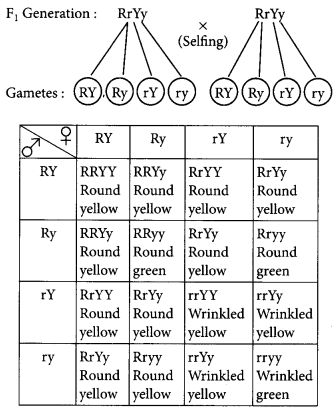
Phenotypic ratio : 9 : 3 : 3 : 1
Round yellow seeds – 9 ; Round green seeds – 3;
Wrinkled yellow seeds – 3; Wrinkled green seeds – 1
Question 26.
(a) Mendel crossed tall pea plants with dwarf pea plants in his experiment. Write his observations giving reasons on the F1 and F2 generations.
(b) List any two contrasting characters other than height that Mendel used in his experiments in pea plants. (Delhi 2014)
Answer:
(a) The possible cross of Mendel’s experiment is: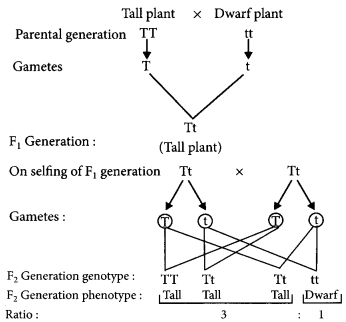
Hence, tall (T) is dominant whereas dwarf (t) is recessive. In F1 generation, only dominant trait expresses itself, whereas recessive trait gets suppressed.
In F2 generation, both traits, i.e., dominant and recessive express themselves. In this way, Mendels experiment showed that the traits (tall and dwarf) are inherited independently.
(b) The two contrasting characters other than height that Mendel used in his experiment in pea plants are round/wrinkled seeds and violet/white flowers.
Question 27.
“A trait may be inherited, but may not be expressed”. Justify this statement with the help of a suitable example. (AI 2014)
Answer:
Refer to answer 20.
Question 28.
“The sex of a newborn child is a matter of chance and none of the parents may be considered responsible for it”. Justify this statement with the help of flow chart showing determination of sex of a new born. (Delhi 2013)
Answer:
Refer to answer 23.
Question 29.
A blue colour flower plant denoted by BB is cross-bred with that of white colour flower plant denoted by bb.
(a) State the colour of flower you would expect in their F1 generation plants.
(b) What must be the percentage of white flower plants in F2 generation if flowers of F1 plants are self-pollinated?
(c) State the expected ratio of the genotypes BB and Bb in the F2 progeny. (Delhi 2012)
Answer:
(a) The colour of the flower in F1 generation will be blue.
(b) If the flowers of F1 generation are self pollinated, then the percentage of white flowers in F2 generation must be 25%.
(c) The expected ratio of the genotypes BB and Bb in the F2 generation progeny is 1 : 2.
The above results could be depicted by the given cross: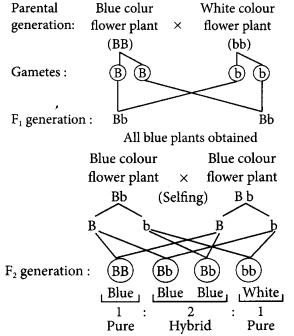
Question 30.
If we cross pure-breed tall (dominant) pea plant with pure-breed dwarf (recessive) pea plant we will get pea plants of F1 generation.
If we now self-cross the pea plant of F1 generation, then we obtain pea plants of F2 generation.
(a) What do the plants of F1 generation look like?
(b) State the ratio of tall plants to dwarf plants in F2 generation.
(c) State the type of plants not found in F1 generation but appeared in F2 generation, mentioning the reason for the same. (AI 2012)
Answer:
(a) The plants of F1 generation will be all tall plants.
(b) The ratio of tall plants to dwarf plants in F2 generation is 3 : 1.
(c) Dwarf plants are not found in F1 generation but appeared in F2 general ion. This is so because in F1 generation only dominant trait (tall) expresses itself and recessive trait (dwarf) gets suppressed. The dwarf plants appeared in F2 generation, because the traits whether dominant or recessive are independently inherited. In others words, a single copy of (T) is enough to make the plant tall, while both copies have to be (t) for the plant to be dwarf.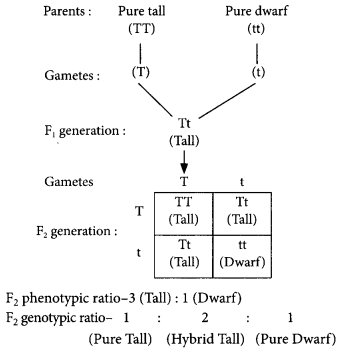
Question 31.
With the help of a flow chart explain in brief how the sex of a newborn is genetically determined in human beings. Which of the two parents, the mother or the father, is responsible for determination of sex of a child? (Foreign 2012)
Answer:
Refer to answer 23.
Question 32.
How is the sex of the child fixed during the fertilisation, step in human beings? Explain. (Foreign 2011)
Answer:
Human beings have 23 pairs chromosomes (22 pairs of autosomes +1 pair of sex chromosome). A male has one X chromosome and one Y chromosome whereas a female has two X chromosomes. Sex of a child depends on the two conditions which takes place during fertilisation. The two conditions are given below:
- If a sperm carrying X chromosome fertilises an ovum which carries X chromosome, then the child born will be girl.
- If a sperm carrying Y chromosome fertilises an ovum which carries X chromosome, then the child born will be a boy.
Question 33.
How do Mendels experiments show that
(a) traits may be dominant or recessive?
(b) inheritance of two traits is independent of each other? (Delhi 2017)
Answer:
(a) Mendel first crossed pure-bred tall pea plants with pure-bred dwarf pea plants and found that only tall pea plants were produced in the first generation (F1). He then self crossed the tall pea plants of the F1 generation and found that tall plants and dwarf plants were obtained in the second generation or (F2) in the ratio of 3 : 1. Mendel said that the trait of dwarfness of one of the parent pea plant had not been lost, it was merely concealed or suppressed in the first generation to re-emerge in the second generation. He called the suppressed trait of ‘dwarfness as ‘recessive trait’ and the expressed trait of ‘tallness’ as the ‘dominant trait’. In this way, Mendel’s experiments with tall and dwarf pea plants showed that the traits may be dominant or recessive.
Hence this could be explained by the given cross :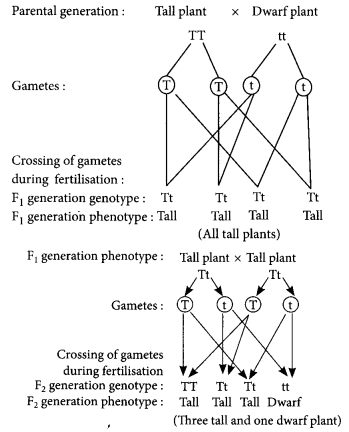
(b) Mendel observed two combinations of characteristics in seeds, round-yellow and wrinkled-green, and two new combinations of characteristics had appeared in the F2 generation, round-green and wrinkled- yellow. According to Mendel’s second law of inheritance more than one pair of traits are considered in a cross simultaneously, the factors responsible for each pair of trait are distributed independently to the gametes.
The cross given below showing dihybrid cross explains that the inheritance of two traits is independent of each other.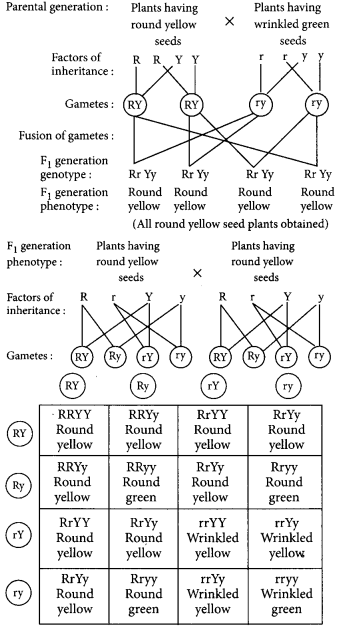
Question 34.
(a) Why did Mendel choose garden pea for his experiments ? Write two reasons.
(b) List two contrasting visible characters of garden pea Mendel used for his experiment.
(c) Explain in brief how Mendel interpreted his results to show that the traits may be dominant or recessive. (Foreign 2016)
Answer:
(a) Mendel choose garden pea for his experiments because:
(i) It was easy to grow and it shows some clear contrasting traits like some pea plants are tall whereas others are dwarf.
(ii) Pea plants are self pollinating and many generation of pea plants can be produced in comparatively less time.
(b) The contrasting characters of garden pea plant studied by Mendel are:
| Character | Plant | |
| Dominant | Recessive | |
| 1. Plant height | Tall | Yellow |
| 2. Colour of the seed | Dwarf | Green |
(c) Refer to answer 17.
Question 35.
Give the respective scientific terms used for studying:
(a) the mechanism by which variations are created and inherited and
(b) the development of new type of organisms from the existing ones. (Delhi 2014)
Answer:
(a) Heredity is the mechanism by which variations are created and inherited.
(b) Evolution is the process in which development of new type of organisms takes place from the existing ones.
Question 36.
Write the contribution of Charles Darwin in the field of evolution. (Delhi 2014)
Answer:
‘Lhe contribution of Charles Darwin in the field of evolution is that only the organism which can adapt; to the changing environmental conditions can survive and he also stated that the natural selection is a process which plays an important role in evolution of plants and animals by selecting the organisms with traits favourable to the environment.
Question 37.
Why do mice whose tails were surgically removed just after birth for generations, continue to produce mice with tails? (Foreign 2014)
Answer:
A group of mice are normally bred and all their progeny possess tail. Now, if the tails of these mice are surgically removed in each generation, tail¬less mice will not be produced. This is so because removal of tail during the life cycle of mice is an acquired character which is not transferred to future generations. The removal of the tail cannot change the genes of the germ cells of the mice.
Question 38.
List two differences between acquired traits and inherited traits by giving an example of each. (Delhi 2019)
Answer:
Differences between the inherited traits and acquired traits are as follows :
| Inherited traits | Acquired traits |
| (i) These are passed from the parent to offspring. | These are developed during the life of an individual. |
| (ii) These are genetic variations. | These are somatic variations. |
| (iii) These develop due to crossing over phenomenon and mutations. | These develop due to use and disuse of organs and direct effect of environment. |
| (iv) These are passed on from one generation to the other. | These traits die with the death of the individual. |
| (v) Example: Skin colour, eye colour, form of hair, polydactyly (extra fingers), free and attached ear lobes, blood groups of human beings. | Example: If a group of mice are normally bred, all their progenies will have tails. Now, if the tails of these mice are removed surgically in each generation, tailless mice will not be produced. It is so because removal of tail is an acquired character and it will not bring change in the genes of the germ cells of the mice. |
Question 39.
Define genetics. Why is decrease in the number of surviving tigers a cause of concern from the point of view of genetics? Explain briefly. (AI 2019)
Answer:
Genetics is the branch of biology that deals with the study of heredity and variations. The term genetics’ was coined by William Bateson in 1906. When a population is small, the number and scope of variations is limited and hence diversity and traits are reduced. Small numbers of surviving tigers are a cause of worry from the point of genetics because of the following reasons:
- Their loss would cause a loss of gene pool, i.e., many genes will be eliminated from a gene pool.
- Tigers are surviving in limited numbers, so if some natural calamity kills these small population of tigers, they will suddenly become extinct as per genetic drift phenomenon,
- A disease may wipe out the leftover population, if the entire population is susceptible to the disease. This can cause sudden extinction of the tiger species and loss of their genes forever, thus, adversely affecting the diversity of nature.
Question 40.
Distinguish between the acquired traits and the, inherited traits in tabular form, giving one example for each. (Delhi 2017)
Answer:
Refer to answer 38.
Question 41.
With the help of two suitable examples, explain why certain experiences and traits earned by people during their lifetime are not passed on to their next generations. When can such traits be passed on? (AI 2017)
Answer:
Certain experiences and traits earned by people during their lifetime are not passed on to their next generations because all these characters are acquired by the man during his lifetime. The man is not born with these traits and he cannot pass on these traits to his children. These could be better explained by the given examples:
(i) Child of a very good swimmer may not know how to swim. This is so because the technique of swimming is not inherited from parents but it is learnt by the person himself or herself.
(ii) A person may have a scar on the face from a cut he got in an accident. This is also an example of acquired trait which cannot be passed to the next generation.
Traits can be passed on to future generations in which changes have occurred in the genes present in the reproductive cells of the parent organisms. These traits or characters are known as inherited traits.
Question 42.
List three distinguishing features, in tabular form, between acquired traits and the inherited traits. (Delhi 2016)
Answer:
Refer to answer 38.
Question 43.
“We cannot pass on to our progeny the experience and qualifications earned during our lifetime.” Justify the statement giving reason and examples. (Delhi 2015)
Answer:
Refer to answer 41.
Question 44.
List in tabular form, two distinguishing features between the acquired traits and the inherited traits with one example of each. (Delhi 2015, AI 2012)
Answer:
Refer to answer 38.
Question 45.
Distinguish between inherited and acquired traits by giving one example of each. Give reason why the traits acquired during the lifetime of an individual are not inherited. (Foreign 2014)
Answer:
Refer to answers 38 and 41.
Question 46.
With the help of suitable examples, explain why certain traits cannot be passed on to the next generation? What are such traits called? (AI 2014)
Answer:
Refer to answer 41.
Question 47.
Tabulate two distinguishing features between acquired traits and inherited traits with one example of each. (Delhi 2013)
Answer:
Refer to answer 38.
Question 48.
“An individual cannot pass on to its progeny the experiences of its life-time”. Justify the statement with the help of an example and also give reason for the same. (Foreign 2012)
Answer:
If we breed a group of mice, all the progeny of mice will have tails just like their parents. Now, if we remove the tails surgically and again breed them, we still get new mice with tails. This is because cutting the tails of mice does not change the genes of their reproductive cells (or gametes). And since the acquired trait of‘cut tails’ does not bring about a change in the genes of mice, this trait cannot be passed on to their next generations. From this we conclude that the experiences acquired by an individual during his lifetime (called acquired traits) cannot be passed on to its progeny, and hence cannot lead to evolution because they are not caused by the change in genes.
Question 49.
Describe any three ways in which individuals with a particular trait may increase in population. (AI 2011)
Answer:
Three ways in which individuals with a particular trait may increase in population are:
(i) Genetic drift : It is the random change in gene frequency occurring by chance fluctuations. In this phenomenon, an event may increase the frequency of a particular trait having little adaptive value and survival advantage.
(ii) Natural selection : It is the phenomenon wherein nature selects traits favourable to the species in the environment. Thus, a particular trait selected by the nature increases in number.
(iii) Geographical isolation : Interbreeding populations are geographically isolated by barriers such as mountain ranges, rivers and sea. This geographical isolation leads to reproductive isolation and thus there is no gene flow between separated groups of population and therefore, population with particular character increases.
Question 50.
(a) What is the law of dominance of traits? Explain with an example.
(b) Why are the traits acquired during the life time of an individual not inherited? Explain. (2020)
Answer:
(a) Mendel’s law of dominance states that for a particular trait one gene is usually expressed over the other. The dominant allele expresses itself and the one which remains unexpressed is called recessive allele. This is called “law of dominance”. E.g., for height, there are two alleles, T for tallness and t for dwarfness.
(b) Refer to answer 41.
Question 51.
What is speciation?
Answer:
The process by which new species develop from the existing species is known as speciation.
Question 52.
What is speciation? Explain in brief the role of natural selection and genetic drift in this process. (Foreign 2016)
Answer:
‘Hie process by which new species develop from the existing species is known as speciation. Both natural selection and genetic drift play a very important role in speciation. By natural selection traits favourable to the species in the given environment are selected by the nature.
Example, beetles develop colour variation during reproduction. Consequently, in the progeny, one beetle develops green body colour instead of normal red colour. This beetle can inherit this variation in colour on to its progeny so that all its offspring are green in colour. Crows cannot easily locate green-coloured beetles on the green leaves of bushes and continue to eat red beetles which are easily located on green leaves. As a result, in population of green beetles increases in each generation.
Genetic drift is the elimination of the genes of certain traits from the small population when a section of population dies of natural calamity or migrates to other region. It alters the gene frequency of the remaining population.
Suppose in sexually reproducing red beetle population, a colour variation arises wherein one beetle develops blue body colour instead of red. This beetle can also pass this colour variation to its progeny so that all its offspring are blue coloured beetles. As the population of beetles expand, initially there would be few blue coloured beetles among the majority of red coloured beetles. At this point, an elephant comes by and stamps on the bushes where the beetles live. Consequently, most of the beetles get killed. By chance, most of the survived beetles are of blue colour. This population again slowly multiply and will contain mostly blue coloured beetles over a period of time. Survival of more blue beetles in the population changed the coloured characteristic from normal red to blue over a period of time. In small population, accidents can change the frequency of some genes in a population, even if it does not give any survival advantage to the possessors.
Question 53.
What is speciation? List four factors responsible for speciation. (Delhi 2015)
Answer:
The process by which new species develop from the existing species is known as speciation. The four factors responsible for speciation are:
- Geographical isolation of a population leads to reproductive isolation and hence speciation.
- Genetic drift leads to the formation of new species by causing drastic changes in the frequencies of particular gene by chance alone.
- Natural selection wherein nature in the wild selects traits favourable to the species in the given environment.
- Random mating resulting in genetic variations in genotype frequencies within the population.
Question 54.
Explain the following:
(a) Speciation
(b) Natural selection. (Al 2015, Delhi 2011)
Answer:
(a) Speciation : Origin of new species from existing one due to reproductive isolation of a part of its population is called speciation.
Suppose a large population of beetle living in an area gets split into two sub populations due to geographical barriers like river, mountain, sea, etc. Then members of these sub-populations will not be able to interbreed. Hence, there will be no gene flow between the members of these populations. After few generations, genetic drift will accumulate different variations in each of the two geographically separated sub-populations. Natural selection may also operate simultaneously in a different way in these geographically isolated sub-populations. This makes geographically isolated sub-populations to become more and more different from each other and ultimately reproductive isolation occurs between individuals of these groups and they transform into new species.
(b) Natural selection is the phenomenon wherein nature, in the wild, selects traits favourable to the species in its environment.
Also refer to answer 52.
Question 55.
List three main factors responsible for the speciation and briefly describe each one of them. (AI 2014)
Answer:
Speciation is the process by which new species develop from the existing species.
The three important factors responsible for the speciation are:
(i) Geographical isolation of a population caused by various types of barriers such as mountain ranges, rivers and sea. Geographical isolation is the major factor in the speciation of sexually reproducing animals because it causes reproductive isolation and interrupts the flow of genes between their isolated populations through the gametes.
(ii) Genetic drift is the elimination of the genes of certain traits from the small population when a section of population dies of natural calamity or migrates to other region. It alters the gene frequency of the remaining population.
(iii) Variations introduced by random mating and hybridisation. Random fusion of gametes adds new alleles and it result in formation of new species.
Question 56.
List three main factors responsible for the rise of a new species giving a brief description about each. (Foreign 2014)
Answer:
Refer to answer 55.
Question 57.
What is meant by the term speciation? List four factors which could lead to speciation. (Delhi 2012)
Answer:
Refer to answer 53.
Question 58.
(a) Classify the following as homologous or analogous pairs:
(i) Broccoli and cabbage
(ii) Ginger and radish
(iii) Forelimbs of birds and lizard
(iv) Wings of a bat and wings of a bird
(b) State the main feature that categorises a given pair of organs as homologous or analogous. (2020)
Answer:
(a) (i) Broccoli and cabbage – Homologous organs
(ii) Ginger and radish – Analogous organs
(iii) Forelimbs of birds and lizard – Homologous organs
(iv) Wings of bat and wings of a bird – Analogous organs
(b) Homologous organs have the same fundamental structure but different in function, while analogous organs have different internal structure but similar functions.
Question 59.
“During the course of evolution, organs or features may be adapted for new functions”. Explain this fact by choosing an appropriate example. (2020)
Answer:
Evolution is the sequence of gradual changes from simple life forms to complex life form. During the evolution process, many organs are adapted for new functions.
The organs which perform different functions in different species but have similar basic structure and similar embryonic origin are called homologous organs. Homologous structures are a result of divergent evolution. Homology indicates common ancestry.
For example, the forelimbs of a frog, a lizard, a bird and a human being show similarity in basic structure. However, these organs perform entirely different functions.
The given figures showing homologous organs :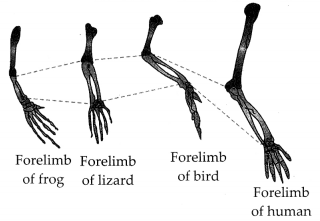
The forelimbs of a frog help the animal to prop up the front end of the body at rest, and also act as shock absorbers when the animal lands on the ground after a leap; the forelimbs of a lizard are modified for creeping movements; the forelimbs of a bird are modified for flying purposes, while the forelimbs of a human being are used for grasping. The basio similarity in the forelimbs of these different vertebrates indicates that all these vertebrates had common ancestry, i.e., they have evolved from a common ancestor who had ‘five digited’ or ‘pentadactyl’ limbs (basic plan of limbs).
This means that these vertebrates have modified according to the special needs of the subsequent generations during the course of evolution.
Question 60.
Explain with the help of an example each, how the following provide evidences in favour of evolution:
(a) Homologous organs
(b) Analogous organs
(c) Fossils (Delhi 2017, AI 2015, Delhi 2011)
Answer:
(a) Homologous organs perform different functions in different species but have similar basic structure and similar embryonic origin. For example, forelimbs of a frog, lizard, bird and human being show similarity in basic structure. However, these organs perform entirely different functions but the basic similarity in the forelimbs of these different vertebrates indicates common ancestry. This means that these vertebrates have modified according to the special needs of the subsequent generations during the course of evolution.
(b) Analogous organs are different in fundamental structure and embryonic origin but have similar appearance and perform similar functions. For example, the wings of an insect and a bird have different structures but they perform the same function of flying. The presence of these organs indicates that they are not derived from common ancestors but they can still evolve to perform similar functions to survive, flourish and keep on evolving in the prevailing environment. This provides a mechanism for evolution.
(c) Fossils are the remains or impressions of the dead animals and plants that lived in the remote past. The fossils provide evidence for evolution. For example, a fossil bird called Archaeopteryx have characters of both reptiles and birds. It had feathers, fused bones and beak which are exclusive characters of birds and had teeth in the jaws, claws on fingers, a long tail, etc like reptiles. Thus, Archaeopteryx is a connecting link between the reptiles and birds, and hence suggests that the birds have evolved from the reptiles through the process of continuous evolution.
Question 61.
“Evolution and classification of organisms are interlinked”. Give reasons to justify this statement. (AI 2017)
Answer:
Evolution is the process by which newer types of organisms are developed from the pre-existing ones through modifications. Classification is the arrangement of organisms into a series of groups based on physiological, biological, anatomical or other relationships. All systems of classification are hierarchial. The more closely two species are related, the more recently they have a common ancestor. Classification of organisms necessarily involves organising them in different groups, based on the similarities and differences of characteristics. It helps in the recognisation of the basic arrangement of a hierarchical structure among diverse species. It facilitates studies or research of wide variety associated with organisms effortlessly. Thus, classification of species is infact a reflection of their evolutionary relationship or we can say that evolution and classification are interlinked.
Question 62.
“Two areas of study namely evolution’ and classification are interlinked”. Justify this statement. (AI 2016)
Answer:
Refer to answer 61.
Question 63.
List three factors that provide evidences in favour of evolution in organisms and state the role of each in brief. (Foreign 2016)
Answer:
Some of the important sources which provide evidences for evolution are homologous organs, analogous organs and fossils.
Also refer to answer 60.
Question 64.
(a) Planaria, insects, octopus and vertebrates all have eyes. Can we group eyes of these animals together to establish a common evolutionary origin? Justify your answer.
(b) “Birds have evolved from reptiles”. State evidence to prove the statement. (Delhi 2015)
Answer:
(a) Planaria, insects, octopus and vertebrates cannot be grouped together on the basis of eye. Eyes of insects, octopus, Planaria and vertebrates are analogous organs which have developed over generation as an adaptation for similar function. They represent convergent evolution where distantly related groups develop similar functional structure as an adaptation for same function.
(b) Fossil bird Archaeopteryx had features like feathers, fused bones, beak which are the characteristic features of birds. It also had some features of reptiles, like, teeth in jaws, claws on free fingers, a long tail, etc. Thus, it represents a connecting link between reptiles and birds. This example provides a clue that birds have evolved from reptiles.
Question 65.
(a) Cite the evidence on the basis of which it is concluded that birds have evolved from reptiles.
(b) Insects, octopus, Planaria and vertebrates also possess eyes. Can these animals be grouped together on the basis of the eyes they possess. Why or why not ? Give reason to justify your answer. (Foreign 2015)
Answer:
(a) Refer to answer 64(b).
(b) Refer to answer 64(a).
Question 66.
(a) Give the evidence that the birds have evolved from reptiles.
(b) Insects, octopus, Planaria and vertebrates possess eyes. Can we group these animals together on the basis of eyes that they possess? Justify your answer giving reason. (Delhi 2014)
Answer:
(a) Refer to answer 64(b).
(b) Refer to answer 64(a).
Question 67.
What are fossils? How do they help in the study of evolution? (Delhi 2013C, AI 2011)
Answer:
Refer to answer 60(c).
Question 68.
Distinguish between homologous organs and analogous organs. In which category would you place wings of a bird and wings of a bat? Justify your answer giving a suitable reason. (Delhi 2012)
Answer:
Those organs which have the same basic structure and similar embryonic origin but different functions are called as homologous organs.
These organs follow same basic plant of organisation during development, but in adults got modified to perform different function as an adaptation to different environments. Those organs which have different basic structure and embryonic origin but perform similar functions are called analogous organs.
The wings of bird and wings of bat are analogous organs because the basic structure or design of the wings of bird and bat are different but they perform the similar function of flying.
Question 69.
How are fossils formed? Describe, in brief, two methods of determining the age of fossils. (AI 2012)
Answer:
When organisms like plants or animals die, their bodies get decomposed by the action of microorganisms in the presence of oxygen, moisture, etc. Sometimes the conditions in the environment are such (like absence of oxygen, moisture, etc.), which do not let the body of the organism to get decompose completely. It is the body (or body part) of an organism which we get as fossil on digging the earth. In many cases the soft parts of the organisms get decomposed and we get skeleton of hard parts (like teeth, bones, etc.) as fossil. Even the soft parts of the plants and animals (which usually decompose quickly) are sometimes preserved as fossils in the form of their impressions inside the rocks. For example, if a dead leaf gets caught in mud, it will not decompose quickly. The mud around the leaf will set around it as a mould,’gradually harden to form a rock and retain the impression of the leaf. This forms a leaf fossil which can be dug out from the earth a after a long time period.
The age of fossils can be determined in two ways as given below:
(i) By the relative method: When we dig into the earth, we find fossils at different depths. The fossils which we find in layers closer to the surface of the earth are more recent and those fossils which are found in deeper layers are older; whereas the fossils found in the deepest layers of earth are the oldest ones.
(ii) Carbon dating method: When a living object dies and forms fossil, its carbon-14 radioactivity goes on decreasing gradually. By this method, the age of fossils is found by comparing the carbon-14 radioactivity left in fossils with the carbon-14 radioactivity present in living objects today.
Question 70.
(a) We see eyes in Planaria, insects, octopus and vertebrates. Can eyes be grouped together in case of the above-mentioned animals to establish a common evolutionary origin? Why?
(b) State one evidence to prove that birds have evolved from reptiles. (Foreign 2012)
Answer:
(a) Refer to answer 64 (a).
(b) Refer to answer 64 (b).
Question 71.
Explain how evolutionary relationship can be traced by the study of homologous organs. (Foreign 2011)
Answer:
Homologous organs provide morphological and anatomical evidences of evolution. There are number of organs in different groups of animals or plants which have similar basic design but are used for different purposes. These are termed as homologous organs. For example, the forelimbs of frog, lizard, bird and human beings show similarity in basic structure. The basic similarity of forelimbs of these different vertebrates indicates that all these have evolved from a common ancestor who had five digited or pentadactyle limbs which became modified according to the special needs of subsequent generations during the course of evolution. Hence, homologous organs depict divergent evolution or adaptive radiation.
Question 72.
(a) How do the following provide evidences in favour of evolution in organisms? Explain with an example for each.
(i) Homologous organs
(ii) Analogous organs
(iii) Fossils
(b) Explain two methods to determine the age of fossils. (AI 2019)
Answer:
(a) Refer to answer 60.
(b) Refer to answer 69.
Question 73.
Define evolution. How does it occur?
Describe how fossils provide us evidence in support of evolution. (AI 2016)
Answer:
Evolution is the sequence of gradual changes, from simple life forms to complex life form, i.e., from primitive organisms that lived over millions of years ago to new organisms that exist today. Evolution occurs by changes, improvement and modification of simple life forms. Fossils are the remains or impressions of organisms that lived in the remote past. Fossils provide the evidence that the present animal have originated from previously existing ones through the process of continuous evolution. Fossils can be used to reconstruct evolutionary history of an organism. The distribution pattern of fossils shows that the ancient fossils present in the bottom rocks are simple, while the most recent fossils found in the upper strata are more highly evolved. It means fossils form and become more and more complex as we proceed from earliest to recent rocks. It gives us an idea of time in history when different species were formed or became extinct. Thus, fossils provide us evidences in support of evolution.
Question 74.
What are fossils? How are they formed? List two methods of determining the age of fossils. Explain in brief the importance of fossils in deciding the evolutionary relationships. (Foreign 2016)
Answer:
Refer to answers 60(c) and 69.
Question 75.
Define the term evolution. “Evolution cannot be equated with progress”. Justify this statement. (2020)
Answer:
Evolution is the sequence of gradual changes which take place in the primitive organisms over millions of years in which new species are produced.
Evolution should not be equated with progress because there is no real progress in the concept of evolution. Evolution is just the production of diversity of life forms and shaping of this diversity by the environmental selection. The only progress in evolution appears to be that more and more complex body designs of organisms have emerged over the ages. This will become clear from the following examples. When a new species is formed, it is not necessary that the old species will disappear or get eliminated from earth.
It will all depend on the environment. Also it is not as if the newly formed species are in any way better than the older ones. It is simply that genetic drift and natural selection processes have combined to form a population having different body design which cannot interbreed with the older population. It is a common belief that chimpanzees are the ancestors of human beings. It is, however, not true that human beings have evolved from chimpanzees. Actually, both chimpanzees and human beings had a common ancestor long time ago. The two offsprings of that ancestor evolved in their own separated ways to form the modern day chimpanzees and human beings.
Question 76.
Define the term “evolution”. Evolution should not be equated with progress.” Give reason to justify this statement. (Foreign 2014)
Answer:
Refer to answer 75.
CBSE Class 10 Science Notes Chapter 9 Heredity and Evolution
Heredity and Inherited Traits: Mendel’s Experiment; Sex determination.
Heredity refers to the transmission of characters from parents to offsprings. An inherited trait is a particular genetically determined feature that distinguishes a person from the others for example; attached or free ear lobes in human beings.
Rules for the inheritance of traits:
Mendel’s contribution: The rules for inheritance of traits in human beings are related to the fact that both mother and father contribute an equal amount of genetic material i.e. DNA to their offspring. So an offspring will get two versions of that trait from the two parents. Mendel worked out rules for inheritance of these traits. Gregor Johann Mendel regarded as the ‘Father of Genetics’ performed his experiments with garden peas (Pisum sativum) in the garden behind his monastery. He observed a number of contrasting characters in garden peas and observed their inheritance.
Some important terms
1. Chromosomes are long thread-like structures present in the nucleus of a cell which contain hereditary information of the cell in the form of genes.
2. DNA is a chemical in the chromosome which carries the traits in a coded form.
3. Gene is the part of a chromosome which controls a specific biological function.
4. Contrasting characters: A pair of visible charactes such as tall and dwarf, white and violet flowers, round and wrinkled seeds, green and yellow seeds etc.
5. Dominant trait: The character which expresses itself in a (Ft) generation is dominant trait. Example : Tallness is a dominant character in pea plant.
6. Recessive trait: The character which does not express itself but is present in a generation is recessive trait. Ex. dwarfism in the pea plant.
7. Homozygous: A condition in which both the genes of same type are present for example; an organism has both the genes for tallness it is expressed as TT and genes for dwarfness are written as tt.
8. Heterozygous: A condition in which both the genes are of different types for example; an organism has genes Tt it means it has a gene for tallness and the other for dwarfness only tall character is expressed.
9. Genotype: It is genetic make up of an individual for example; A pure tall plant is expressed as TT and hybrid tall as Tt.
10. Phenotype: It is external appearance of the organism for example; a plant having Tt composition will appear tall although it has gene for dwarfness.
11. Homologous pair of characters are those in which one member is contributed by the father and the other member by the mother and both have genes for the same character at the same position.
Mendel’s Experiment: Mendel started his experiment on the pea plants. He conducted first monohybrid and then dihybrid crosses.
Monohybrid Cross: The cross in which Mendel showed inheritance of dominant and recessive characters is monohybrid cross. To observe inheritance of single pair of contrasting characters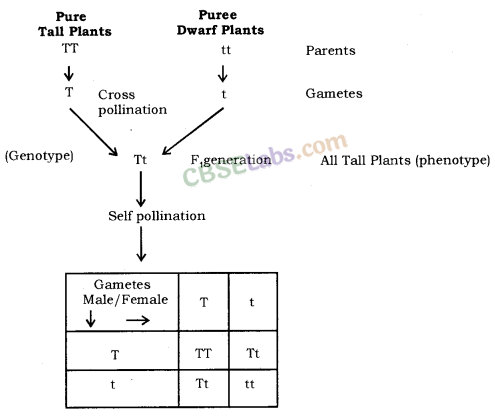
he took pure tall (genotype TT) and pure dwarf (genotype tt) pea plants and cross pollinated them to obtain first generation or first filial generation. In this figuration (F1 generation) he obtained only tall plants. This meant that only one of the parental traits was seen, not the mixture of the two. The plants of F generation or progeny are then self pollinated to obtain F2 generation or progeny. Now all plants were not tall. He obtained 75% tall plants and 25% dwarf plants i.e. the phenotypic ratio was 3:1. This indicates that in the F, generation both tall and dwarf traits were inherited but tallness expressed it self. Tallness is a dominant trait and dwarfness is a recessive trait. F2 generation has a genotypic ratio of 1 : 2 : 1 of three types of plants represented by TT, Tt and tt as shown in the cross.
Conclusion: Phenotypic ratio—Tall : Dwarf 3 : 1
Genotype ratio—Pure Tall : Hybrid Tall : Pure Dwarf 1 : 2 : 1
Law of Dominance: When parents having pure contrasting characters are crossed then only one character expresses itself in the Ft generation. This character is the dominant character and the character/factor which cannot express itself is called the recessive character.
Dihybrid Cross: Mendel also carried out experiments to observe inheritance of two pairs of contrasting characters, which is called dihybrid cross. He cross breed pea plants bearing round green seed with plants bearing wrinkled and yellow seeds. In the Fx generation he obtained all round and yellow seeds it means round and yellow traits of seeds are dominant features while wrinkled and green are recessive. He self-pollinated the plants of F: generation to obtain F2 generation, he obtained four different types of seeds round yellow, round green, wrinkled yellow and wrinkled green in the ratio of 9 : 3 : 3 : 1. He concluded that traits are independently inherited
Conclusion
- Round and yellow seeds-9.
- Round and green seeds-3.
- Wrinkled and yellow seeds-3.
- Wrinkled and green seeds-1.
How do traits get expressed?
Cellular DNA is the information source for making proteins in the cell.
A part of DNA that provides information for one particular protein is called a gene for that protein for example; the height of a plant depends upon the growth hormone which is in turn controlled by the gene. If the gene is efficient and more growth hormone is secreted the plant will grow tall. If the gene for that particular protein gets altered and less of it is secreted when the plant will remain short. Both the parents contribute equally to the DNA of next generation during sexual reproduction. They actually contribute a copy of the same gene for example; when tall plant is crossed with short plant the gametes will have single gene either for tallness or for shortness. F1 generation will get one gene for tallness and other for shortness also.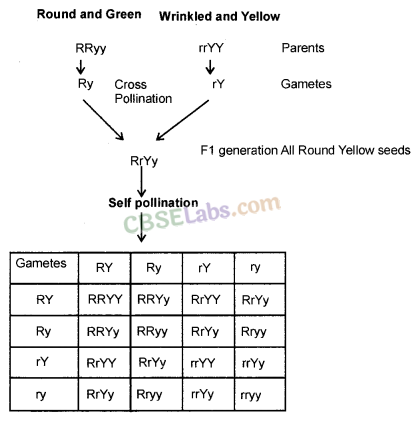
How do germ cells i.e. gametes get single set of genes from parents who have two copies in them ?
Each gene set is present, not as a single long thread of DNA, but as separate independent pieces each called a chromosome. Each cell gets two copies of the chromosome, one from each parent. Each germ cell or gamete has one copy of it because there is reductional division in the sex organs at the time of formation of gametes. When fertilization takes place normal number of chromosomes is restored in the progeny ensuring the stability of DNA of the species.
How is the sex of a newborn individual determined?
It is the process by which sex of a newborn can be determined.
Different species use different strategies for this :
- In some animals the temperature at which fertilized eggs are kept determines whether the developing animals will be males or females.
- Some animals like snails can change sex indicating that sex is not genetically determined.
- In human beings sex of the individual is determined genetically; means genes inherited from the parents decide the sex of the offspring.
Sex determination in human beings: In human beings, all chromosomes are not paired. 22 chromosomes are paired but one pair called sex chromosome is odd in not having a perfect pair in males. Females have a perfect pair both represented by XX. On the other hand males have a normal sized X but the other is short called Y so it is shown as XY. All gametes or ova formed by the homogenetic female are similar i.e. have X chromosome. Males heterogenetic form two types of sperms i.e. half with X chromosome and the other half with Y chromosome. Sex of the baby will depend on fertilization. There are two possibilities :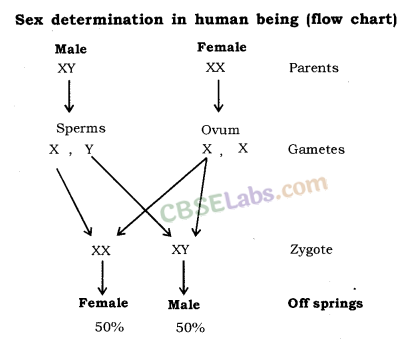
Autosomes: Those chromosomes which do not play any role in sex determination.
Sex chromosomes: Those chromosomes which play a role in determining sex of the newborn.
- If the sperm having X chromosome fertilizes with ovum with X chromosome then the baby will have XX chromosome and it will be female.
- If the sperm having Y chromosome fertilizes with ovum with X chromosome then the baby will have XY chromosomes and it will be male.
Evolution: Acquired and inherited traits, Speciation, Evolution and classification, Evolution by stages, Human evolution.
Evolution: It is the sequence, of gradual, irreversible changes which took place in the primitive organisms over millions of years to form new present-day species. Variations that resulted in formation of new species occurred basically due to errors in DNA copying as well as due to sexual reproduction.
An Illustration to show variations in a population: A group of twelve red beetles live in green bushes and reproduce sexually so are likely to develop variations. There are the following possibilities
First situation: Crows eat these beetles as they can easily pick up red ones in the green bushes There is a colour variation during sexual reproduction and green beetles appears, it reproduces and its population increases. Crows are not able to see green beetles so their population continues to increase but that of red beetles decreases. This type of variation gives a survival advantage.
Second situation: Due to a colour variation few blue beetle appear forming blue population. Crows can see both red and blue and eat them. Initially there are more of red beetles and less of blue. There is sudden calamity, an elephant kills red beetles by stamping on bush, blue beetles survive reproduce and increase in number. In this case there is no survival advantage but provides diversity without any adaptation.
Third situation: As the population of beetles increases, the bushes suffer from a disease and the availability of food for beetles decreases. The size of beetles decrease but after a few years as the plant disease is eliminated and enough food is available for the beetles they come back to their normal size. This type of change is not inherited.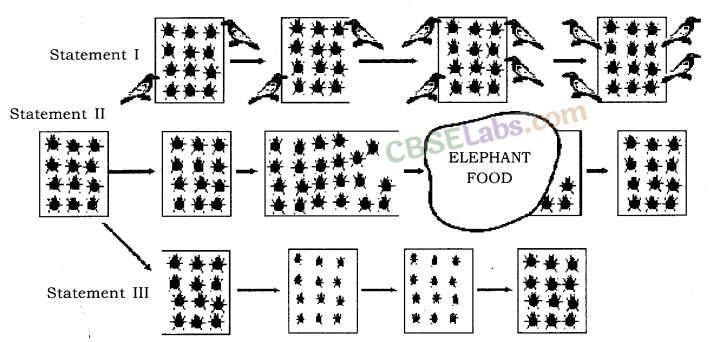
Acquired Traits: Acquired traits are those which are not inherited over generations as they are caused due to change in the non-reproductive tissue and are not passed on the DNA of the germ cells for example; the size of the beetles in the population decreased due to scarcity of food.
Inherited Trait: Inherited traits are caused due to changes in the DNA of germ cells which are inherited from generation to generation, for example; formation of green beetles in the population of red beetles.
Acquired Traits and Inherited Traits
| Acquired Traits | Inherited Traits |
| (i) These are the traits which are developed in an individual due to special conditions. | (i) These are the traits which are passed from one generation to the next. |
| (ii) They cannot be transferred to the progeny. | (ii) They get transferred to the progeny. |
| (iii) They cannot direct evolution, e.g. low weight of starving beetles. | (iii) They cannot direct evolution, e.g. low weight of starving beetles. |
Charles Darwin’s Idea of Evolution: His concept of evolution was based on the idea that new species were formed due to variations that occurred in the organisms Nature played an important role in selecting the organisms having suitable variations.
Speciation: It means the development of one or more species from an existing species The factors that could lead to rise of a new species are :
Gene flow: It means the exchange of genetic material by interbreeding between populations of the same species or between individuals within a population. It increases the variation in the genetic composition of a population.
Genetic drift: It is random change in the frequency of alleles in a populate over successive generation due to errors in the gametes. The process is rapid in smaller population. Genetic drift can lead to accumulation of changes in the generations.
Natural selection: According to Darwin, natural selection also plays an important role in bringing about evolution of new species of plants and animals. According to him variations existed between the individuals of a population and some natural phenomena eliminated those individuals which were less adapted. The surviving population would pass the hereditary advantageous features to their offsprings. With time this process would give rise to organisms different from the original population and new species are formed.
Isolation: When a population of a species splits into two, it cannot reproduce with each other and forms a new species, for example; when a population of beetles feed on bushes on a mountain range, some may start feeding on nearby bushes finding entry into a new subpopulation. They reproduce with them so genes enter in a new population. Ultimately the two groups will be incapable of reproducing with each other and new species will be formed.
Evolution and Classification: The organisms show certain features, like appearance and behaviour which are called characteristics for example; Plants can perform photosynthesis. The basic characteristics are shared by a large number of organisms. More characteristics which two species have in common more closely are related, if they are more closely related then they have common ancestors (explain the example of brother sister and cousins). Evolutionary relationships can be traced with the help of the following :
Homologous organs: Those organs which have the same basic structural design and developmental origin but perform different functions and appearance, for example; Forelimbs of frog, lizard, bird, bat and human beings. They have same design of bones but they perform different functions.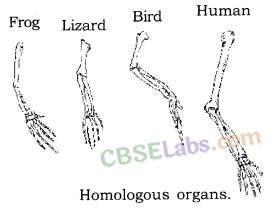
Analogous organs: Those organs which have different basic design and developmental origin but have similar appearance and perform a similar function, for example; wings of bat and bird. Wings of bat are folds of skin attached between fingers. But wing of birds are modified forelimbs.
Study of Fossils: Fossils are preserved remains of living organisms that lived in the past. When living organisms die their bodies decompose but some parts of their body may be in such an environment that they do not decompose for example; if a dead insect gets caught in hot mud it will not decompose quickly but the mud will harden and retain impressions of the body parts of the insects. These impressions are also called fossils: The age of fossil can be estimated in two ways :
The fossils that occur closer to earth surface are more recent to those found in deeper layers.
The second method is isotope dating i.e. detecting the ratio of different isotopes of the same element in the fossil material.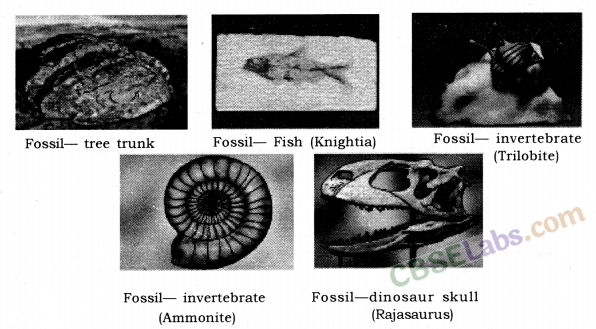
Significance of fossils: Fossils are formed layer by layer in the earths crust. The animals and plants which existed earlier are buried in the deeper layer which ones found in the upper layer. It is found that, deeper fossils have simpler structure than found than upper layer. Complete fossil record of animals like horse, camel, man has helped us to study the stages of evolution.
Evolution by stages: Evolution is a continuous and gradual process, complicated organs did not evolve by a single DNA change but were formed by bit by bit change over generations for example; complex organs like eyes were created by bit by bit changes, in between the rudimentary eye in some insects also provided a fitness advantage. The structure of eye in all organisms is different enough to have evolutionary origins. Some organs even developed for one particular function but later become useful for quite a different function, e.g Feathers developed to provide warmth to the animal but later helped in flight.
Some dinosaurs had feathers although they could not fly, this shows that birds are closely related to reptiles, since dinosaurs were reptiles Some dissimilar looking structures also evolved from common ancestors. The current example of such a process is wild cabbage plant from which different vegetables are generated by artificial selection rather than natural selection
- Selection of short distance between the leaves has led to formation of cabbage that, we eat.
- Selection for arrested flower development had led to broccoli,
- Selection for sterile flowers had made cauliflower,
- Selection for swollen-stem had formed kohlrabi.
- Selection for large leaves had formed leafy vegetable kale,
- Selection for colored leaves formed red cabbage.
To sum up we can say that evolutionary relationships can be established by
- Study of Homologous organs
- Study of Analogous organs
- Study of fossils
- Changes in DNA during reproduction
Evolution versus Progress: Evolution can not be called progress from lower forms to higher forms. It is basically forming more complex designs while the simpler once also keep growing. Evolution is generation of diversity with the help of environmental selection. Bacteria which were formed first have the capacity to live in diverse conditions and are still flourishing; on the other hand human beings which are highly evolved species can not be called the pinnacle of evolution but yet another species in the evolving life forms.
Human Evolution: Human evolution has been studied with the help of excavation; time dating and fossil study All human beings belong to single species i.e. Homo sapiens. Human species have come from Africa. Some of our ancestors left Africa while others stayed on. These migrants slowly spread across the planet i.e. West Asia, Central Asia, Eurasia, South Asia and East Asia They traveled to Indonesia, the Philippines, Australia and America They traveled forward and backward sometimes separating and sometimes coming back to mix with each other. They had come into being as an accident of evolution.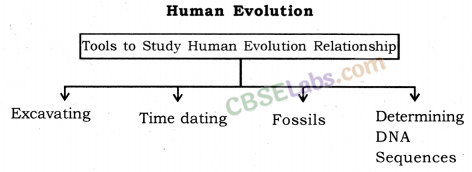
Although there is a great diversity of human forms all over the world get all humans are single species.
- They didn’t go in a single line.
- They went forward and backward.
- Moved in and out of Africa.
- Sometimes come back to mix with each other.
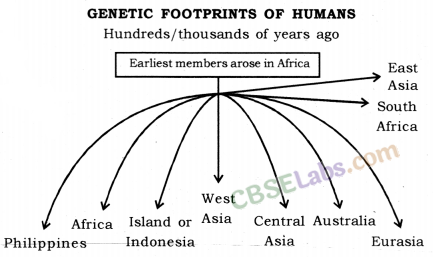
Genetics: Branch of science that deals with heredity and variation.
Heredity: It means the transmission of features/characters/traits from one generation to the next generation.
Variation: The differences among the individuals of a species/population are called variations.
Mendel and his work on Inheritance.
Gregor Johann Mendel started his experiments on plant breeding and hybridisation. Mendel was known as Father of Genetics.
The plant selected by Mendel was Pisutn sativum (garden pea). Mendel used a number of contrasting characters for garden pea.
Sex Determination: Phenomenon of decision or determination of sex of an offspring.
Factors Responsible for Sex Determination:
- Environmental: In some animals, the temperature at which the fertilised eggs are kept decides the gender. Example, in turtle.
- Genetic: In some animals like humans gender or individual is determined by a pair of chromosomes called sex chromosomes (XX – female; XY – male).
Sex Chromosomes: In human beings, there are 23 pairs of chromosomes. Out of these 22 chromosome pairs are called autosomes and the last pair of chromosomes that help in deciding the gender of that individual are called sex chromosome.
XX – female; XY – male
The cross done shows that half the children will be boys and half will be girls. All children will inherit an X chromosome from their mother regardless of whether they are boys or girls. Thus sex of children will be determined by what they inherit from their father, and not from their mother.
Acquired Traits:
- These are the traits which are developed in an individual due to special conditions.
- They cannot be transferred to the progeny.
- They cannot direct evolution, for example, the low weight of starving beetles.
Inherited Traits:
- These are the traits which are passed from one generation to the next.
- They get transferred to the progeny.
- They are helpful in evolution, for example, the colour of eyes and hair.
Microevolution: It is the evolution which takes place on a small scale. Example, change in body colour of beetles.
Speciation: It is the process of formation of new species. A species is a group of similar individuals that belong to a population that can interbreed and produce fertile offspring. Speciation takes place when the variation is combined with geographical isolation.
Gene flow: It is the exchange of genetic material by interbreeding between populations of the same species or individuals. Gene flow occurs between populations that are partly but not completely separated.
Genetic Drift: It is the random change in the frequency of alleles (gene pair) in a population over successive generations.
Genetic drift takes place due to:
- severe changes in the DNA.
- change in the number of chromosomes.
Natural Selection: The process by which nature selects and consolidates those organisms which are more suitably adapted and possesses favourable variations.
Evolution and classification. Both evolution and classification are interlinked.
- Classification of species is a reflection of their evolutionary relationship.
- The more characteristics two species have in common the more closely they are related.
- The more closely they are related, the more recently they have a common ancestor.
- Similarities among organisms allow us to group them together and to study their characteristics.
Tracing Evolutionary Relationships:
- Homologous Organs: Morphological and anatomical evidences. These are the organs that have same basic structural plan and origin but different functions.
Example, forelimb of a horse (running), wings of bat (flying), paw of a cat (walk/ scratch/ attack) — same basic structure but different functions. - Analogous Organs: These are the organs that have different origin and structural plan but same functions.
Example, wings of a bat (elongated fingers with skin folds), wings of bird (feathery covering along the arm) — different structures but same functions. - Fossils: The remains and relics of dead organisms that lived in the remote past. Fossils provide evidence of evolution. Example, a fossil called Archaeopteryx has feathered wings like birds but teeth and tail like reptiles hence suggesting that birds and reptiles had a common ancestor.
Artificial Selection: Humans have been a powerful agent in modifying wild species to suit their own requirement throughout ages by using artificial selection. Example, wheat (many varieties obtained due to artificial selection).
1. Heredity : It refers to the transmission of characters or traits from the parents to their offspring. Heredity is the continuity of features from one generation to another which are present in fertilised egg or zygote. The zygote develops into an organism of a particular type only.
2. Genetics : It is the branch of biology which deals with heredity and variation. Genetics is to help our understanding of heredity by knowing how offspring inherit characteristics from their parents.
3. Variation : It means the differences in the characters or traits among the individuals of a species. Variations occur during reproduction both because of error in DNA copying and as a result of sexual reproduction. Variations contribute to evolution.
Causes of variations:
- Different combinations of genetic material.
- Some positive gene mutations.
- Interaction of genes with environmental changes (adaptations).
Importance of variations:
- It forms, the. basis of heredity.
- It causes adaptations due to which organism can easily adjust to its changing environment.
- Accumulation of variations forms the basis of evolution.
Remember!
Variations are produced both in sexual and asexual reproduction but amount of variations produced in asexual reproduction are subtle (so little) that they are hardly noticeable as compared to variations caused due to sexual reproduction.
4. Genotype : The genetic constitution of an organism e.g., Genotype of human male is 44 + XY and
genotype of human female is 44 + XX
5. Phenotype : The appearance of the organism, i.e., the way in which genotype is expressed. Phenotype is the result of interaction of genes with the environment.
e.g., Red colour may be controlled by a pair of genes RR. Now if genotype is RR phenotype will be red only but if genotype is Rr then also phenotype will be red since R is a dominant gene.
6. Gene : It is the basic unit of inheritance by which characters are transferred from parents to their offspring. Gene consists of a specific length of DNA on a chromosome. A specific Segment of DNA that provides the information for one protein is called gene for that protein.
According to Mendel, both parents must contribute equally to the DNA of the progeny during sexual reproduction. As both parents determine the trait in the progeny, so both parents must be contributing a copy of the same gene.
7. Chromosomes : These are the long threads present in the nucleus of every cell. Chromosomes are made- up of DNA and protein. Each chromosome contains very long molecule of DNA.
Remember!
Each gene set is present as separate independent pieces each called a chromosome. Each cell have two copies of each chromosome, one each from male and female parents. Every germ cell will take one chromosome from each pair and these may be of either maternal or paternal origin. When two germ cells combine, they will restore the normal number of chromosomes in the progeny, ensuring the stability of the DNA of the species. Such mechanism of inheritance is used by all sexually and asexually reproducing organisms.
8. Allele: It is an alternative form of a gene occupying the same position on a chromosome and affecting the same characters but in two alternative ways, e.g., the free and attached ear lobe are the alleles of ear lobe character.
Expressing allele of a gene :
- Homozygous dominant in capital letters, e.g., tallness(TT)
- Homozygous recessive in smalMetters, e.g., shortness or dwarfness (tt)
- Heterozygous (Tt)-lt will be called hybrid tall.
9. Dominant allele: An allele that affects the phenotype of an organism both in heterozygous and homozygous condition. It is denoted by a capital letter, e.g., tallness in pea plant is denoted by ‘T.
10. Recessive allele: An allele that affects the phenotype of the organism in absence of a dominant allele, i.e., in homozygous recessive individuals. It is denoted by a small alphabet, e.g., dwarfness in pea plant is denoted by’t’.
11. Homozygous: When both alleles of a particular gene are the same, e.g., TT
12. Heterozygous : When both alleles of a particular gene are different, e.g., Tt
13. Diploid : Cells or organism containing two sets of genes, e.g., human body cells. Diploid cells have genetic constitution of 2n.
14. Haploid : Cells or organism containing one set of genes, e.g., human reproductive cells (sperms and ova). Haploid cells have genetic constitution of n.
15. Monohybrid cross : A cross between two parents taking the alternative traits of one single character, e.g., A cross between tall and dwarf pea plants.
Monohybrid Ratio :
- In F1 generation : 100% hybrid
- In F2 generation : phenotypic ratio is 3 : 1 and genotypic ratio is 1 : 2 : 1
16. Dihybrid cross: A cross between two parents taking into consideration alternative traits of two different characters, e.g., A cross between two pea plants one having round, green seeds and the other having wrinkled, yellow seeds.
Dihybrid Ratio :
- F1 ratio is 100% Hybrid type.
- F2 ratio : Phenotypic is 9 : 3 : 3 : 1 and Genotypic . ratio is very complex.
17. Human Blood Groups: There are four types of blood groups A, B, AB or O. These are controlled by a gene which is denoted by symbols IA, IB and IO (sometimes also denoted as i). The genes IA and IB show no dominance over each other (they are codominant, i.e., both expresses themselves independently). But these both genes are dominant over the gene IO. Therefore, blood group of a person depends on the type of genes present, e.g., (i) Blood group A has the following gene types :
18. Determining sex of a newborn individual genetically:
- In human beings the sex of the individual is ” determined genetically.
- There are 23 pairs of chromosomes of which 22 are similar in male and female and are known as autosomes.
- The remaining one is sex chromosome which is XY in males and XX in females.
- Males produce two types of sperms X and Y, while female produces one type of egg X.
- If a X type of sperm fertilizers the egg then the sex of baby will be female (XX).
- If Y type of sperm fertilizers the egg then the sex of the baby will be male (XY).
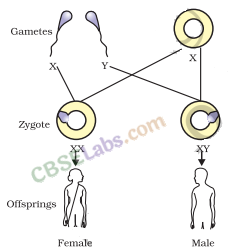
19. Mendel’s experiment to show that traits may be dominant or recessive:
- Mendel conducted breeding experiments in garden pea.
- selected pure plant of a tall/short plant.
- produced first generation plants by crossing them.
- found that all plants were tall.
- produced the second generation by self-fertilization of hybrids.
- found that three-quarter of the plants was tall and one quarter was short.
20. Homologous chromosomes: A pair of corresponding chromosomes of the same shape and size, one from each parent.
21. Autosomes and Sex chromosomes : The identical » chromosome pairs are called autosomes. The
chromosome pair which is different are called sex chromosomes. Humans have 23 pairs of chromosomes. 1-22 pairs are autosomes while 23rd pair (XX in females and XY in males) which are designated as X and Y are sex chromosomes.
22. Molecular Phylogeny: It is the study of evolutionary relationships by comparing DNA of different species.
23. Natural selection : Natural selection is one of the basic mechanisms of evolution, along with mutation, migration and genetic drift. Natural selection means the environmental conditions prevailing around an organism against which organism adapts itself, grows – and reproduces further. This leads to a change in the composition of genes within a population further causing evolution. Thus, it can be said that,
Natural selection results in adaptation in population to fit their environment better. Thus, natural selection direct evolution in the population of a particular species.
24. Fossils of the information which they provide regarding evolution: Fossils are the remains of ancient life forms, which got preserved somehow in the layers of earth, snow or oil.
Information given by fossils:
- They reveal that the life forms which existed earlier do not exist today which indicate that the living forms are ever changing (evolving).
- They are used to guess the time when a particular organism existed on earth. It is done through carbon dating.
25. Genetic drift: The change in the frequency of some genes in a population which provides diversity without any survival advantage is called genetic drift.
26. The various ways in which individuals with a particular trait may increase in a population : Differences in population are responsible for the diversity such as, colour of eyes, hair, shape of ear lobes. This occurs due to : (i) Sexual reproduction (ii) Inaccuracies during DNA replication (iii) Due to environmental changes. This diversity will increase with time as these variations can be passed on only through DNA/genes during reproduction through reproductive tissue (germ cells or gametes).
- If these variations give survival advantage, then such traits are selected in nature and such traits increase in a population.
- Due to genetic drift. This occurs due to geographical or reproductive isolation. It results in the change in gene frequency in a particular: population.
- Migration which leads to gene flow in and out of the population.
- The mutation caused due to particular type of environment. ,
- Acquired traits due to particular type of environment.
27. Evidence of evolution: Errors in DNA copying (mutation) and sexual reproduction lead to variations which form the basis of evolution. Characteristics that
are common in different kinds of living organisms provide evidence in favour of evolution.
28.Evolution : Evolution can be defined as a naturally occurring slow, continuous and irreversible process of change. The gradual change of living organisms from pre-existing organisms since the beginning of life is called organic evolution. Whereas, gradual change in elements from one form to another with time is termed as inorganic evolution, i.
29.Inherited traits : are those traits which are passed from one generation to another through specific genes. Any change in DNA of the germ cells will be passed.
30. Acquired traits : are those traits which are acquired by the organism in its lifetime, e.g., removal of tail cannot change the genes of the germ cells of the mice thus cannot be passed to next generation.
31. Speciation : It means the origin of new species from the existing ones. It happens when different populations of the same species evolve along different lines.
How speciation occurs ?
- It occurs when two populations are isolated (both geographically and reproductively) leading to almost no gene flow between the two populations.
- Over generations, genetic drift will accumulate different changes in each sub-population.
- Natural selection may also operate differently in these different locations.
- Together natural selection and genetic drift will cause such changes (severe changes in the DNA) that these two groups will not be able to reproduce with each other even if they happen to meet.
- When DNA changes occur to larger extent, it may lead to change in the number of chromosomes or gene expression, eventually the germ cells of the two groups cannot fuse with each other. This leads to emergence of new species.
32. Estimating Age of Fossil: There are 2 methods :
- Relative method : On digging, the fossils which are closer to the surface are more recent than the fossils found in deeper layers.
- Dating fossils (carbon dating method): It is done by detecting the ratios of different isotopes of the same element (i.e., isotope of C-14 which is radioactive) in the fossil material.
33. Evolution by stages :
Complex organs like eye has evolved from rudimentary organs, (e.g., rudimentary eye in flatworm might be useful enough to give only a fitness advantage and the structure of eye in different organisms is different indicating them to have different evolutionary origins) not by a single DNA change but created bit-by-bit over generations.
A change that is useful for one property to start with can become useful later for quite a different
function (e.g., Feathers might start as providing insulation in cold weather. But later, they might be useful for flight. Some heavy birds and reptiles also have feathers but they do not fly.
Some very dissimilar looking structures evolve from a common ancestral design, e.g., wild cabbage was cultivated as a food plant and many different vegetables were generated by selection over last two thousand years, (a) Selection of very small distances between the leaves gave rise to cabbage we eat. (b) Selection for arrested flower development gave rise to broccoli, (c) Selection for sterile flowers gave rise to cauliflower (d) Selection for swollen parts gave rise to kohlrabi.(e) Selection for larger leaves gave rise to leafy vegetable kale. It suggests that, if these selections were not done then there would have been only wild cabbage.
34. Homologous organs are organs having same origin and basic structure but they appear different and perform different functions in various organisms,
e.g.,
- Forelimbs of horse and arms of man.
- Wings of birds and flippers of whale.
Similarities in basic structure of (homologous) organs in different organisms, indifferent groups indicate common ancestry.
35. Analogous organs are organs, which look similar because they perform same function, but they do not have same origin and basic structure.
e.g.,
- Wings of birds and wings of insects.
- Fins of fish and flippers of the whale.
NCERT Exemplar Class 10 Science Chapter 9 Heredity and Evolution
Short Answer Questions
Question 1. Do genetic combination of mothers play a significant role in determining the sex of new born?
Answer. No, mothers have no role in determining the sex of the new born. Mothers have a pair of X chromosome. And all children will inherit an ‘X’ chromosome from their mother regardless of whether they are boys or girls.
Question 2. Mention three important features of fossils which help in the study of evolution.
Answer. The three important features of fossils that help in the study of evolution are as follows:
- It helps in establishing the time period in which the organisms lived.
- It helps in establishing evolutionary traits among organisms and their ancestors.
- It is the mode of preservation of the remains of ancient species.
Question 3. In human beings, the statistical probability of getting either a male or female child is 50 : 50. Give a suitable explanation.
Answer. The sex of a child is determined by the type of sex chromosome contributed by male gamete. The statistical probability of getting either a male or female child is 50: 50, because the ratio of male gametes containing X chromosome and those containing Y chromosome is 50 : 50.
Question 4. What are homologous structures? Give an example. Is it necessary that homologous structures always have a common ancestor?
Answer. Homologous organs are those organs which have the same basic structural design and developmental origin but have different functions and appearance. Example: The forelimb of a frog, a lizard, a bird and a man seem to be built from the same basic design of bones, but they perform different functions.
Yes, it is necessary that homologous structures always have a common ancestor in order to carry out the different activities. Otherwise there cannot be any similarity in basic plan, internal structure, development or origin.
Question 5. Does the occurrence of diversity of animals on earth suggest their diverse ancestry also? Discuss this point in the light of evolution.
Answer. Diversity of animals does not mean that they have diverse ancestry because common ancestry greatly limit the extent of diversity. If the animals are inhabiting in the same habitat their evolution by speciation and geographical isolation is also not likely. Animals having a common ancestor have developed new traits forming various groups of animals.
Question 6. A woman has only daughters. Analyse the situation genetically and provide a suitable explanation.
Answer. The women produces ova with ‘X’ chromosome and man produces sperms with X and Y chromosome.
If the husband of the woman transfer X chromosome, then child will be a girl. On the other hand, if the husband transfer Y chromosome, the child will be a boy. In the case, the husband is always transferring X chromosome and hence, all the children are girl.
Long Answer Questions
Question 7. Give reasons why acquired characters are not inherited.
Answer. Acquired characters are not inherited because they do not produce change in the DNA of germ cells, only those characters which have a gene for them can be inherited.
Question 8. Does geographical isolation of individual of a species lead to formation of a new species? Provide a suitable explanation.
Answer. Yes, geographical isolation of individual of a species lead to the formation of a new species.
Geographical isolation of a population leads to genetic drift and there will be no gene flow between it and the parent species. Inbreeding in small population will reproduce among themselves and generate new variations. Accumulation of those variations over several generations will lead to formation of new species.
Question 9. Bacteria have a simpler body plan when compared with human beings. Does it mean that human beings are more evolved than bacteria? Provide a suitable explanation.
Answer. Both bacteria and human beings perform all activities of life to live in their environment. Human beings have more complex organisation and differentiation which are absent in bacteria. Since, complexity and differentiation develop only through evolution, humans are more evolved than bacteria.
Question 10. Evolution has exhibited a greater stability of molecular structure when compared with morphological structures. Comment on the statement and justify your opinion.
Answer. There is immense diversity in size, form, structure and morphological features in the living world. At the molecular level, these diverse types of organisms exhibit similarity of the basic bio molecules like DNA, RNA, carbohydrates, proteins, etc.
Question 11. Study the following cross and showing self-pollination in Flf fill in the blank and answer the question that follows (Q12, Q13 and Q14):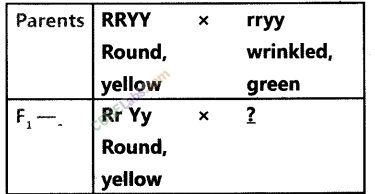
Answer. Rr Yy Round, yellow.
Question 12. In previous question, what are the combinations of character in the F2 progeny? What are their ratios?
Answer. Round yellow – 9, Round green – 3, Wrinkled yellow – 3 Wrinkled green – 1, Le. 9 : 3 : 3 : 1.
Question 13. Give the basic features of the mechanism of inheritance.
Answer. Basic features for the mechanism of Inheritance are as follows:
- Characters are controlled by genes,
- Each gene controls one character.
- Genes are located oh chromosomes.
- There may be two or more forms of gene.
- An individual possess two forms of genes whether similar or dissimilar.
- One form may be dominant over the other.
- The two alleles separate at the time of gamete formation.
- The two forms are brought together in the zygote.
- Alleles of different genes located on separate chromosomes behave independent of one another.
Question 14. Give reasons for the appearance of new combinations of characters in the F2 progeny.
Answer. An organism can inherit each character independently. So, in the F2 progeny new combination of character appears. Tall/ Short and Round/Wrinkled seed trait are independently inherited.
Extra Questions – Heredity and Evolution – CBSE Class 10 Science
According to new CBSE Exam Pattern, MCQ Questions for Class 10 Science pdf Carries 20 Marks.
Question-1
What is heredity?
Solution:
The continuity of features from one generation to another is known as heredity. It is also defined as the transmission of traits from parents to the offsprings.
Question-2
Name the plant on which Mendel performed his experiments.
Solution:
Mendel performed his experiments on the plant, Pisum sativum – the garden pea plant.
Question-3
Define variation.
Solution:
Children do not resemble their parents completely. They possess characters obtained from both the parents. These changes in the phenotypic and genotypic characters are known as variations. Thus a given population of a species has indefinite variants.
Question-4
Define a gene.
Solution:
A gene is a small portion of the DNA, with codes for a particular polypeptide or a protein. In other words, it is the functional unit of the DNA. It is also responsible for the transmission of hereditary characters from the parents to the offspring.
Question-5
Write the expanded form of DNA.
Solution:
The expansion for DNA is Deoxyribonucleic Acid.
Question-6
What are the components of the chromosome?
Solution:
A chromosome consists of two Chromatids joined together at the centromere. The chromaid consists of the DNA material wound over small protein molecules called histones.
Question-7
What is a retrovirus?
Solution:
A retrovirus is a virus that has RNA as its genetic material instead of DNA. HIV virus is a retrovirus.
Question-8
What is a sex chromosome?
Solution:
Chromosomes that are responsible for the determination of sex in an individual are known as sex chromosomes. There are two types sex chromosomes – the X chromosome and the Y chromosome. Males possess one X and one Y chromosome and females possess two X chromosomes.
Question-9
How is sex determined in human beings?
Solution:
The male sex gametes have X and Y chromosomes, whereas the female sex gametes have two X chromosomes. When a sperm containing a Y chromosome fuses with the ovum containing X chromosome, the zygote develops into a male. When a sperm containing the X chromosome fuses with an ovum containing X chromosome, the zygote develops into a female. Thus the sex of an individual is determined by the sex chromosomes X and Y, which is present in the male chromosomes.
Question-10
Define homologous organs.
Solution:
Homologous organs are those organs, which have similar origin and basic plan of development, but may or may not differ in their functions. The forelimbs of a human, a bird and a horse are homologous organs.
Question-11
Explain Darwin’s theory of evolution.
Solution:
Darwin’s theory of evolution is also known as the Theory of Natural Selection or Darwinism. Darwin explained that despite having enormous potential of fertility, the population size of any kind of organism remains within a limit. It is due to the struggle between members of the same species and different species for food, space and mate. This struggle eliminates the unfit individuals. In other words, the fit organisms possess some variations, which are favorable and can leave the progeny to continue the variations. This is called Natural Selection.
Question-12
Define Genetics. What is the contribution of Mendel in the field of genetics?
Solution:
The branch of biology that deals with the study of heredity and variations is known as Genetics. Gregor Johann Mendel was the first person to carry out experiments regarding the heredity of certain characters from one generation to another in a scientific manner. He worked mainly on the garden pea plant. His observations regarding the occurrence of contrasting characters in various generations of garden pea led him to interpret that these are controlled by units which he called, factors. These factors are today known as genes. He is also known as the Father of Genetics.
Question-13
Where are the genes located? What is the chemical nature of genes?
Solution:
Genes are segments of the DNA, which is wound compactly into chromosomes. A gene is composed of a specific sequence of nucleotides. A nucleotide is made up of a nitrogenous base, a sugar molecule and a phosphate group.
Question-14
During which stage can the chromosomes be seen clearly? Write the features of the eukaryotic and prokaryotic chromosomes.
Solution:
Chromosomes are distinctly visible during the Metaphase stage of mitosis of a cell.
The features of eukaryotic and prokaryotic chromosomes are as follows
Eukaryotic chromosomes
1. They are present in large numbers.
2. In higher organisms it occurs in paired condition.
3. They are visible distinctly only during the metaphase stage of mitosis.
4. Each chromosome consists of two chromatics attached together by a centromere.
Prokaryotic chromosomes
1. They are simple in composition when compared to the eukaryotic chromosomes.
2. They are generally circular in shape.
3. There is only one chromosome in a cell.
Question-15
Who provided the evidence of DNA as the genetic material? Write the names of the components of the DNA molecule.
Solution:
Frederick Griffith, Avery, Mc Leod and Mc Carty established that DNA was the carrier of the genetic information.
The DNA molecule is a polynucleotide. A nucleotide is made up of a nitrogenous base, a sugar molecule and a phosphate group.
Question-16
What do you understand by the double helical structure of DNA? Who proposed this structure?
Solution:
James Watson and Francis Crick proposed the double helical structure of the DNA. According to this structure,
• DNA molecule consists of two polynucleotide strands forming a double helix. Each helical turn has a length of 3.4nm in which ten nucleotides are present.
• Each polynucleotide strand has a backbone of sugar and phosphate. The nitrogenous base is attached to the sugar.
• The nitrogenous bases of the two strands of a double helix form a pair with the help of hydrogen bonds. Adenine pairs with thymine by two hydrogen bonds, whereas guanine pairs with cytosine by three hydrogen bonds.
• The hydrogen bonds hold the two strands of the helix together.
Question-17
Describe the different types of chromosomes.
Solution:
The different types of chromosomes are,
Metacentric
It is a chromosome with the centromere near the middle and the two chromatics are of equal lengths.
Sub-metacentric
Here the centromere is situated slightly closer to one end than the other. Thus one chromatic is slightly longer than the other.
Acrocentric
Here the chromosome is situated near one end of the chromosome. Thus one chromatic is very long while the other is very small.
Telocentric
Here the centromere is situated at the tip of the chromosome.
Question-18
How do embryological studies provide evidence for evolution?
Solution:
The embryology of different vertebrates provide very strong evidence favoring organic evolution. The early embryos of different vertebrates show striking similarities. This indicates common origin and ancestry of different vertebrates. Thus embryological studies provide direct evidence for evolution.
Question-19
Define evolution. Describe the contribution of Lamarck.
Solution:
Evolution is referred to as the changes acquired by a species or a certain population of a species gradually over a long period of time. These changes should be heritable.
Contribution of Lanark
According to the Theory of inheritance of acquired characters or Lamarckism, put forward by Lanark, the use and disuse of an organ leads to acquiring change in the features of that organ. These changes are also inherited by the offspring’s. The favorable variations caused due to use and disuse after a considerably long period of time, results in evolution of a new species.
Question-20
How do homologous organs provide evidence in support of evolution?
Solution:
The presence of homologous organs indicates that all vertebrates have a common ancestry. Similarly, all organs and systems of the vertebrates show fundamental similarities, which point towards common ancestry.
NCERT Solutions for Class 10 Science All Subject NCERT Solutions
- Chapter 1 Chemical Reactions and Equations
- Chapter 2 Acids, Bases and Salts
- Chapter 3 Metals and Non-metals
- Chapter 4 Carbon and Its Compounds
- Chapter 5 Periodic Classification of Elements
- Chapter 6 Life Processes
- Chapter 7 Control and Coordination
- Chapter 8 How do Organisms Reproduce?
- Chapter 9 Heredity and Evolution
- Chapter 10 Light Reflection and Refraction
- Chapter 11 Human Eye and Colourful World
- Chapter 12 Electricity
- Chapter 13 Magnetic Effects of Electric Current
- Chapter 14 Sources of Energy
- Chapter 15 Our Environment
- Chapter 16 Management of Natural Resources
.png)
.png)